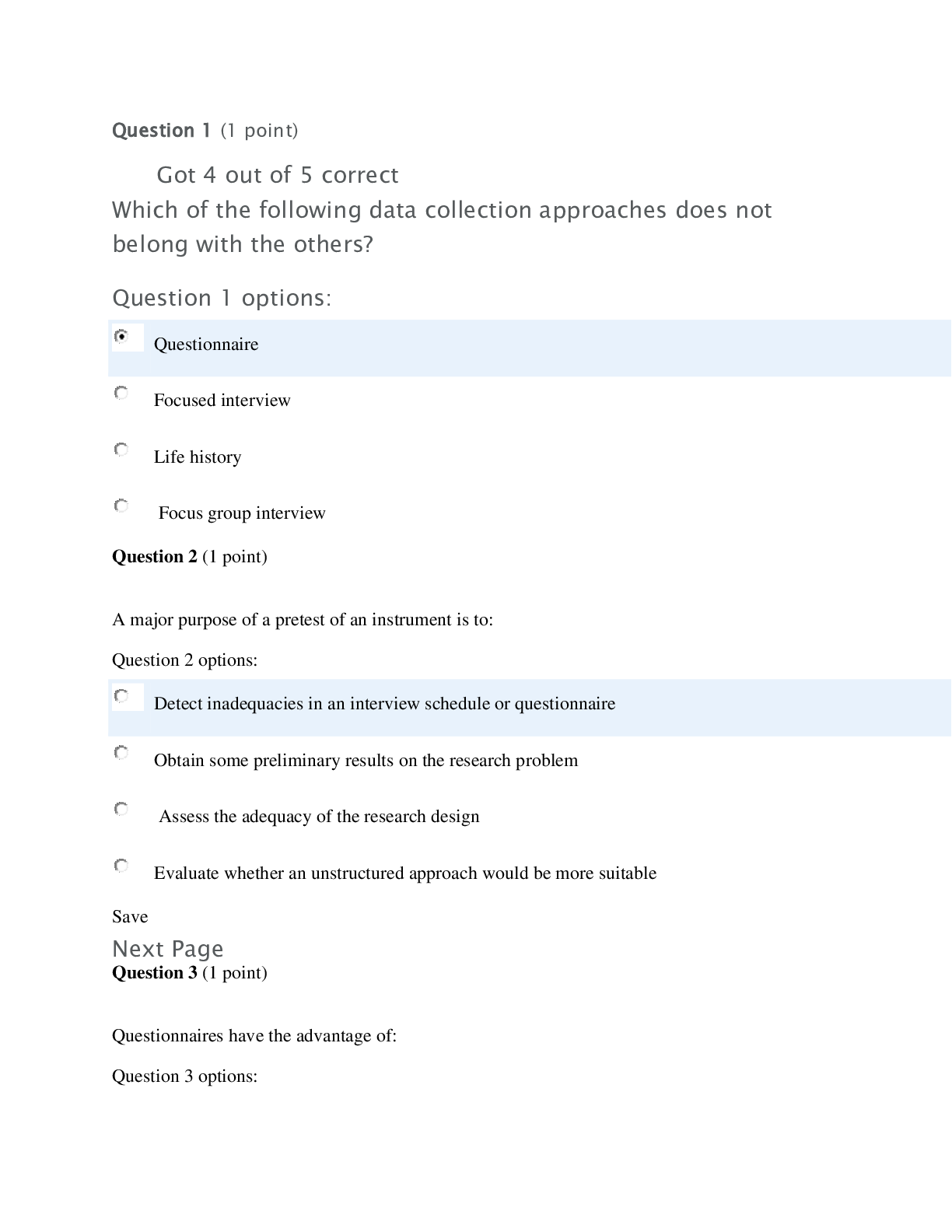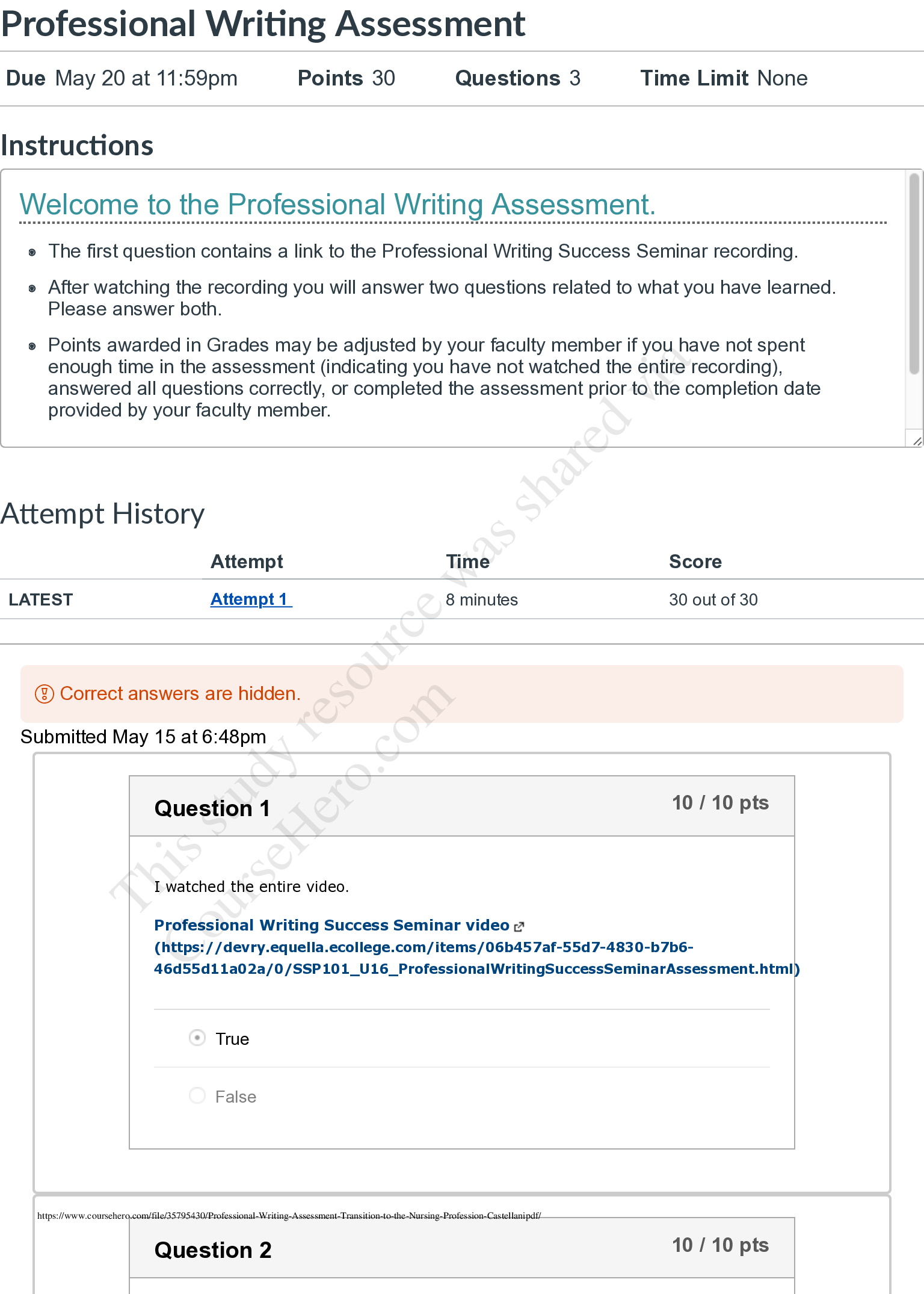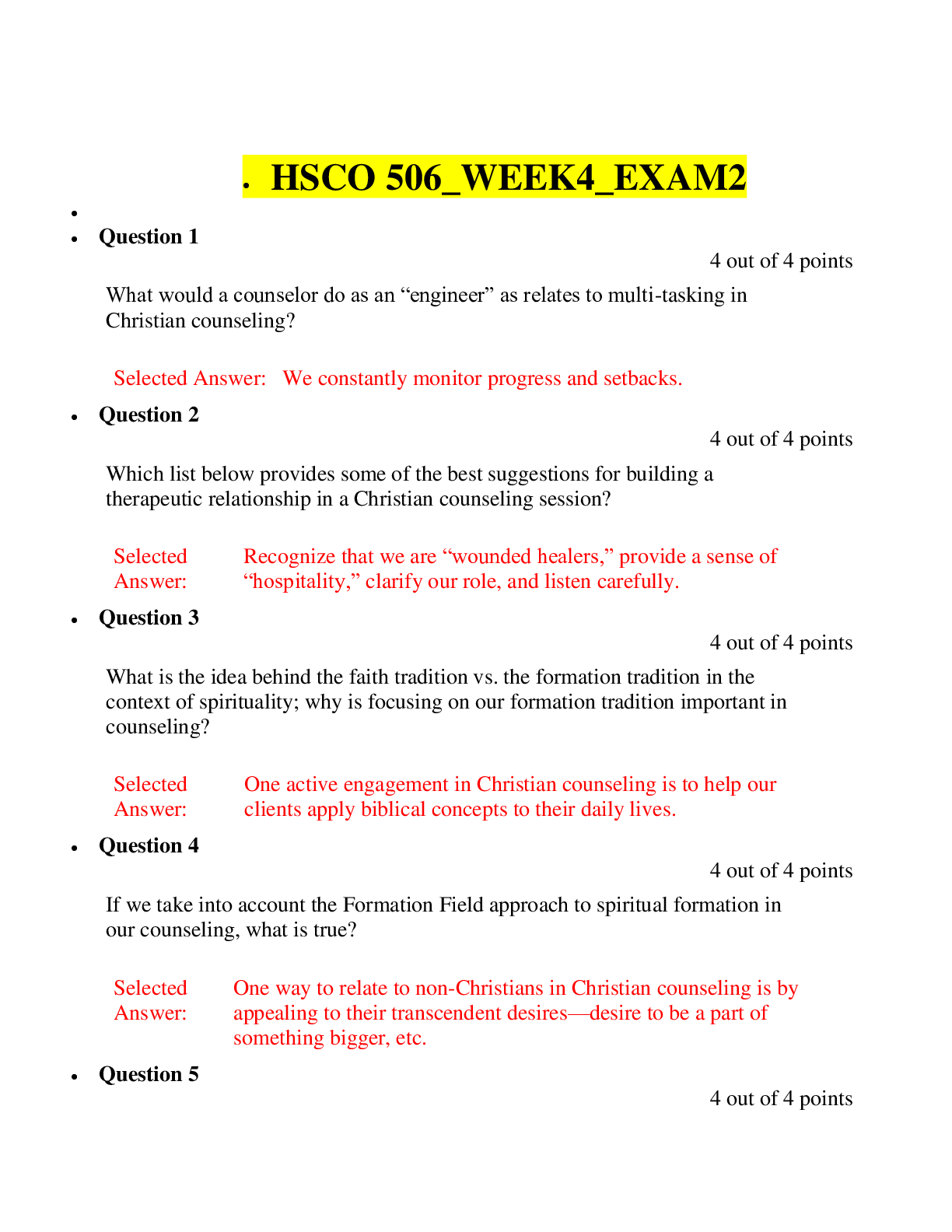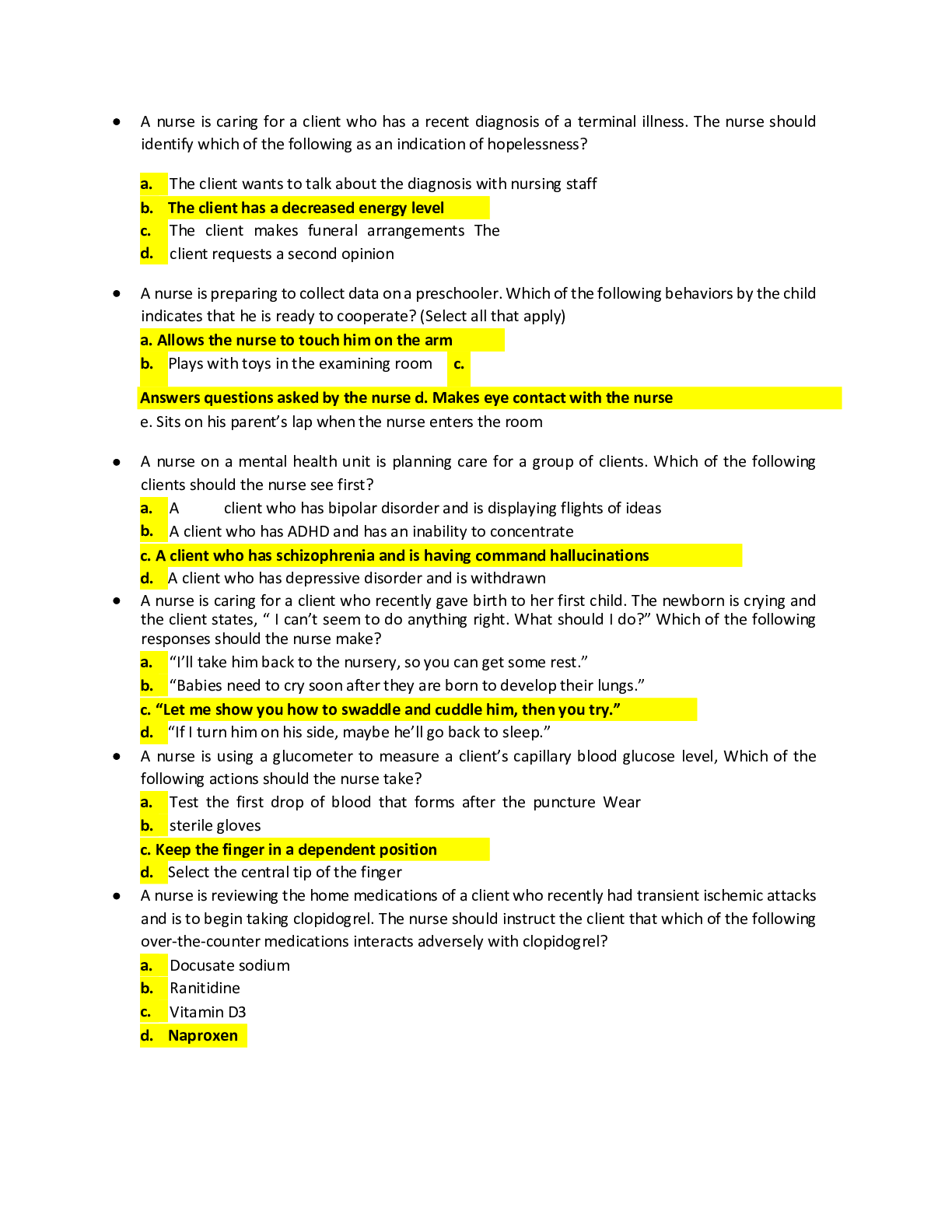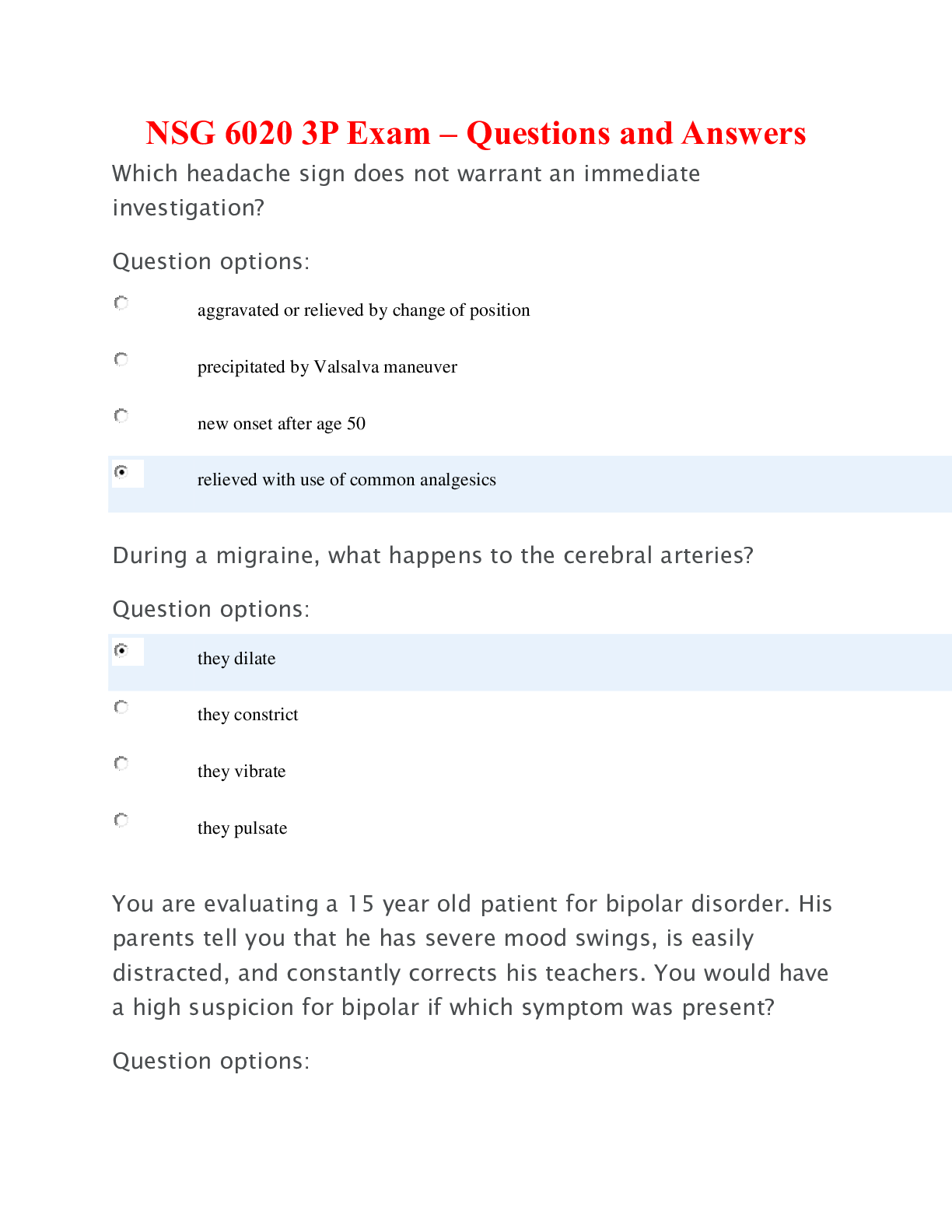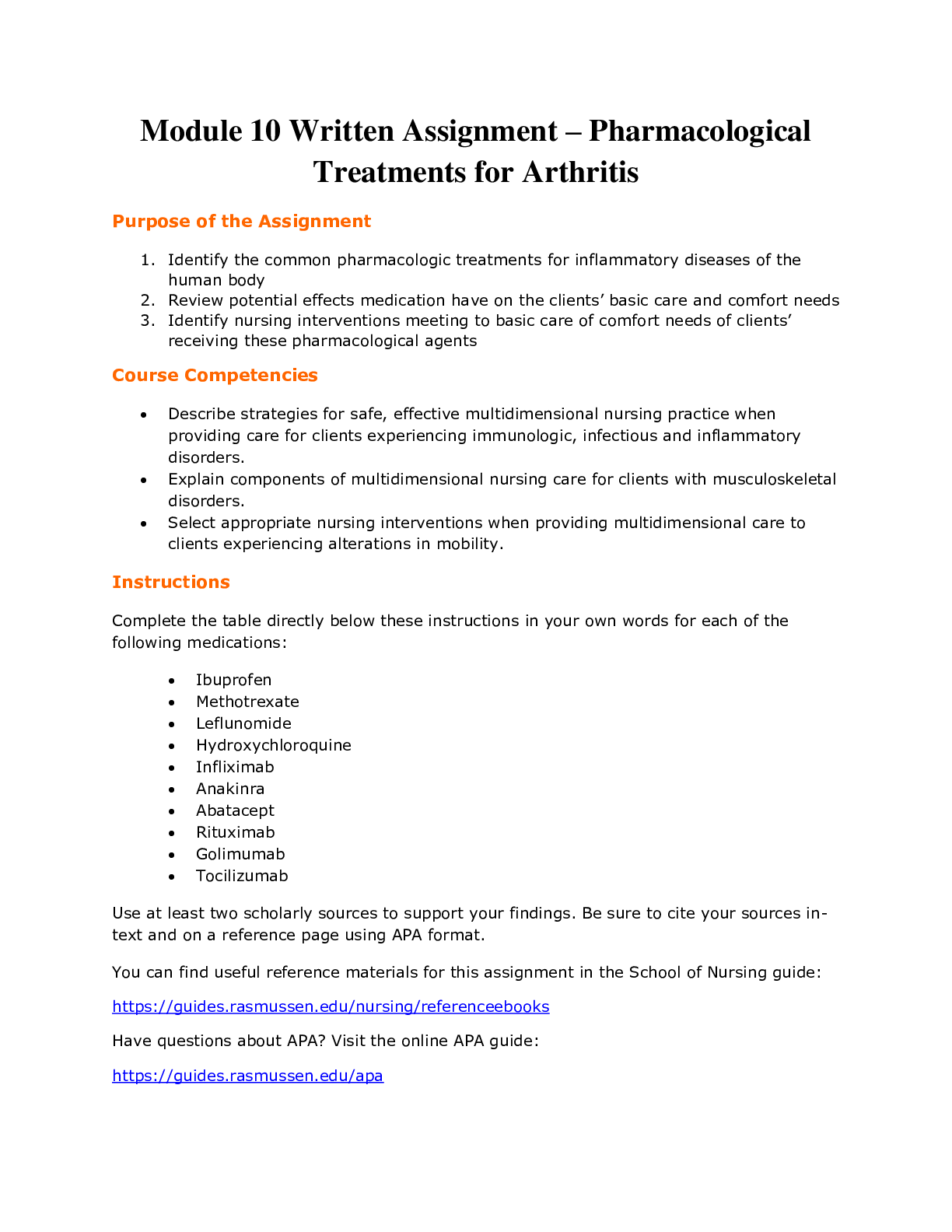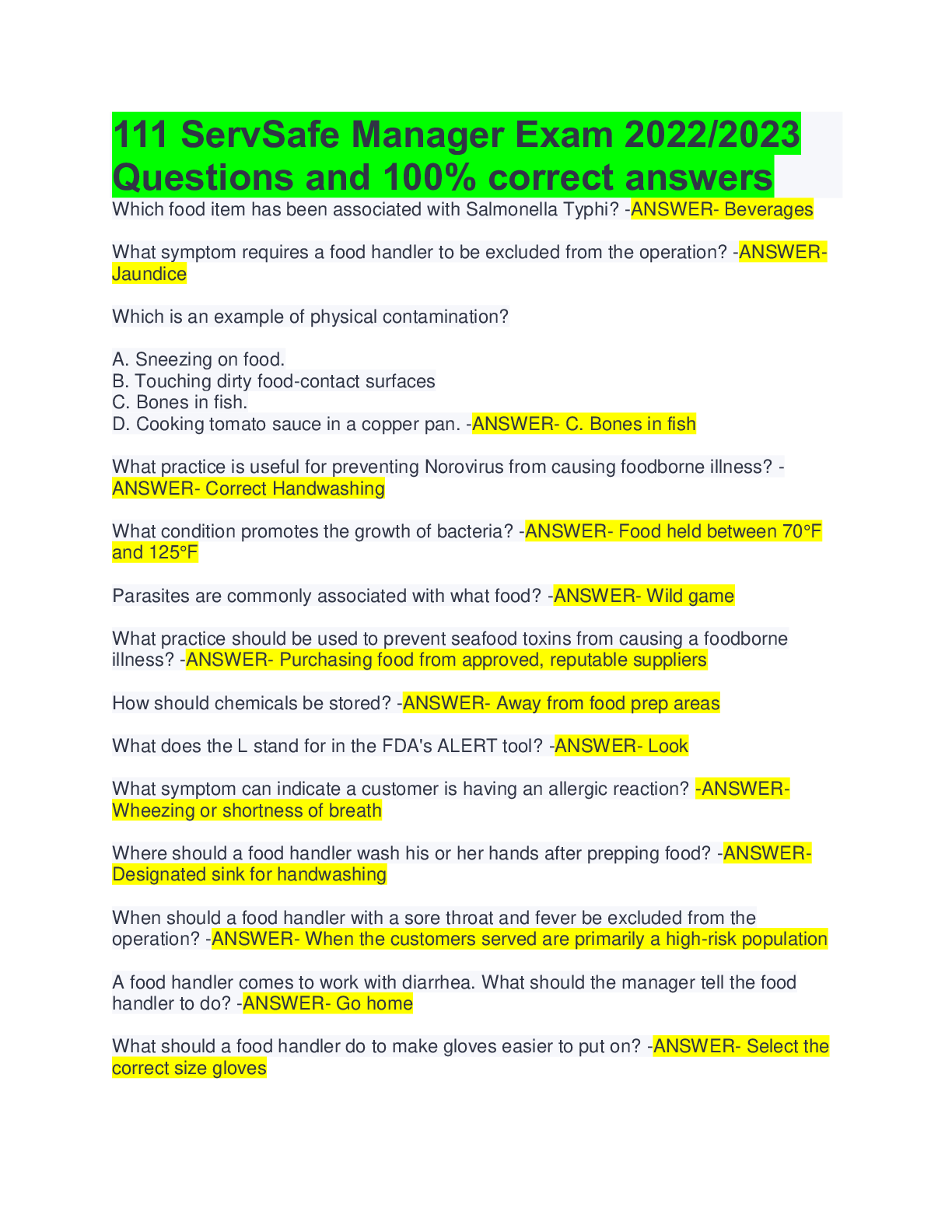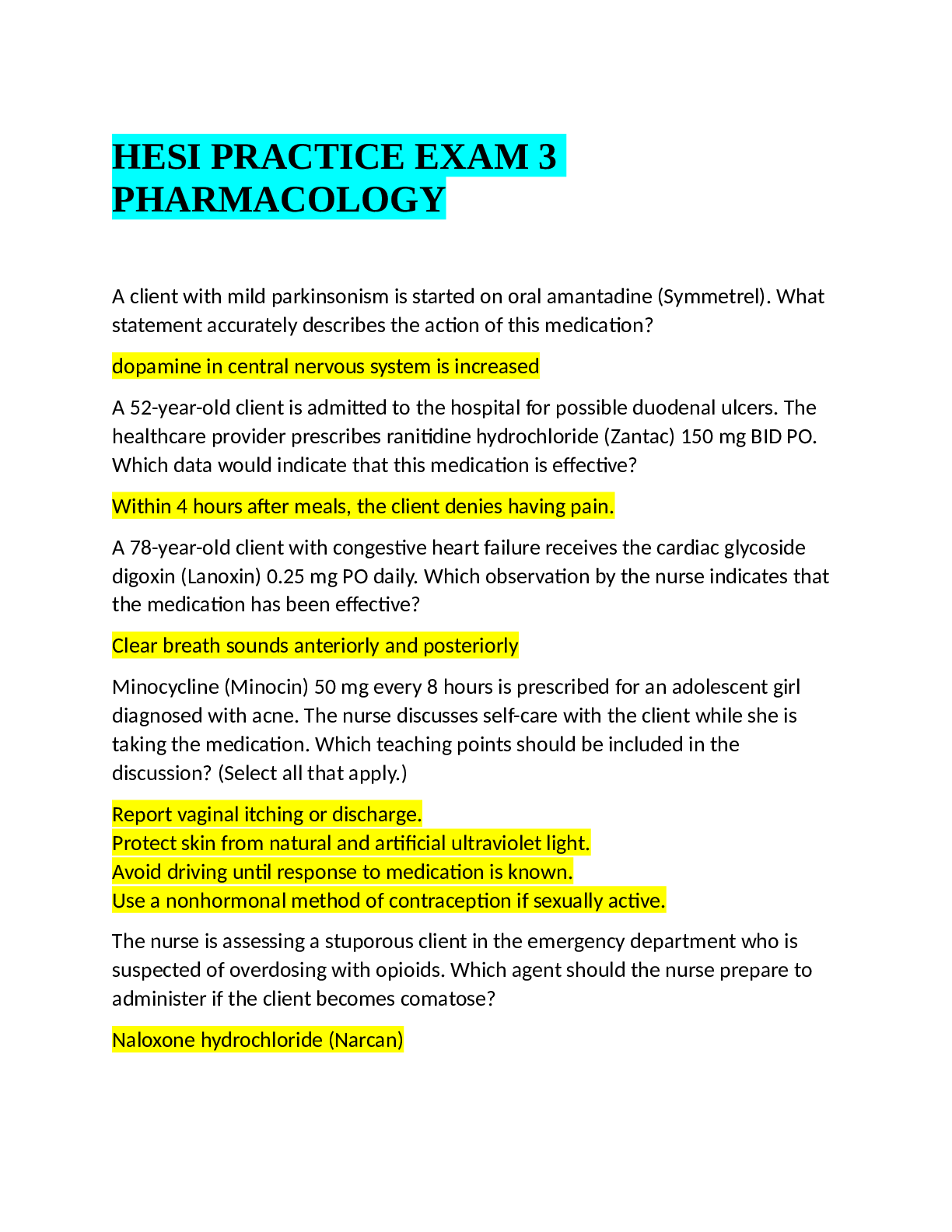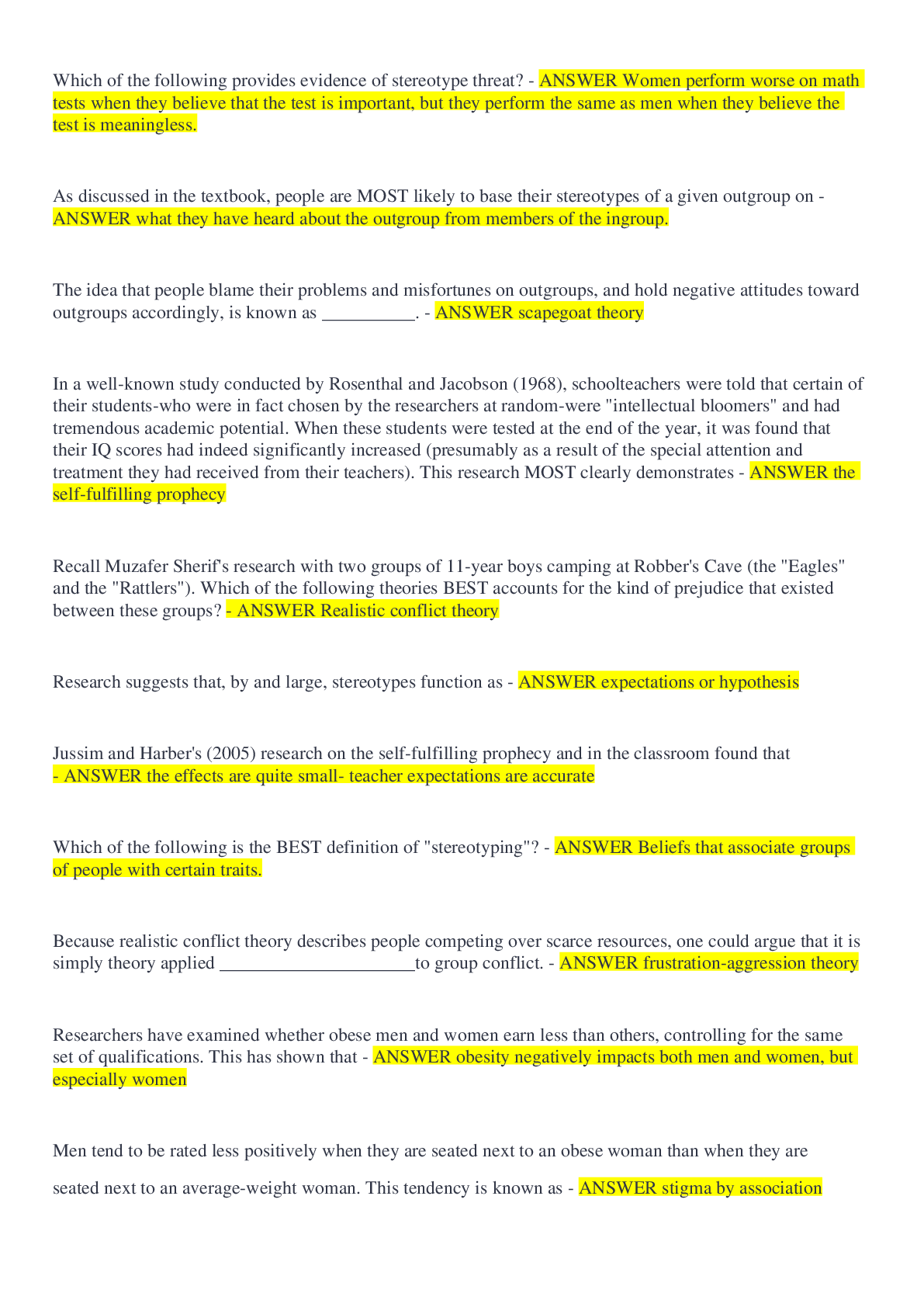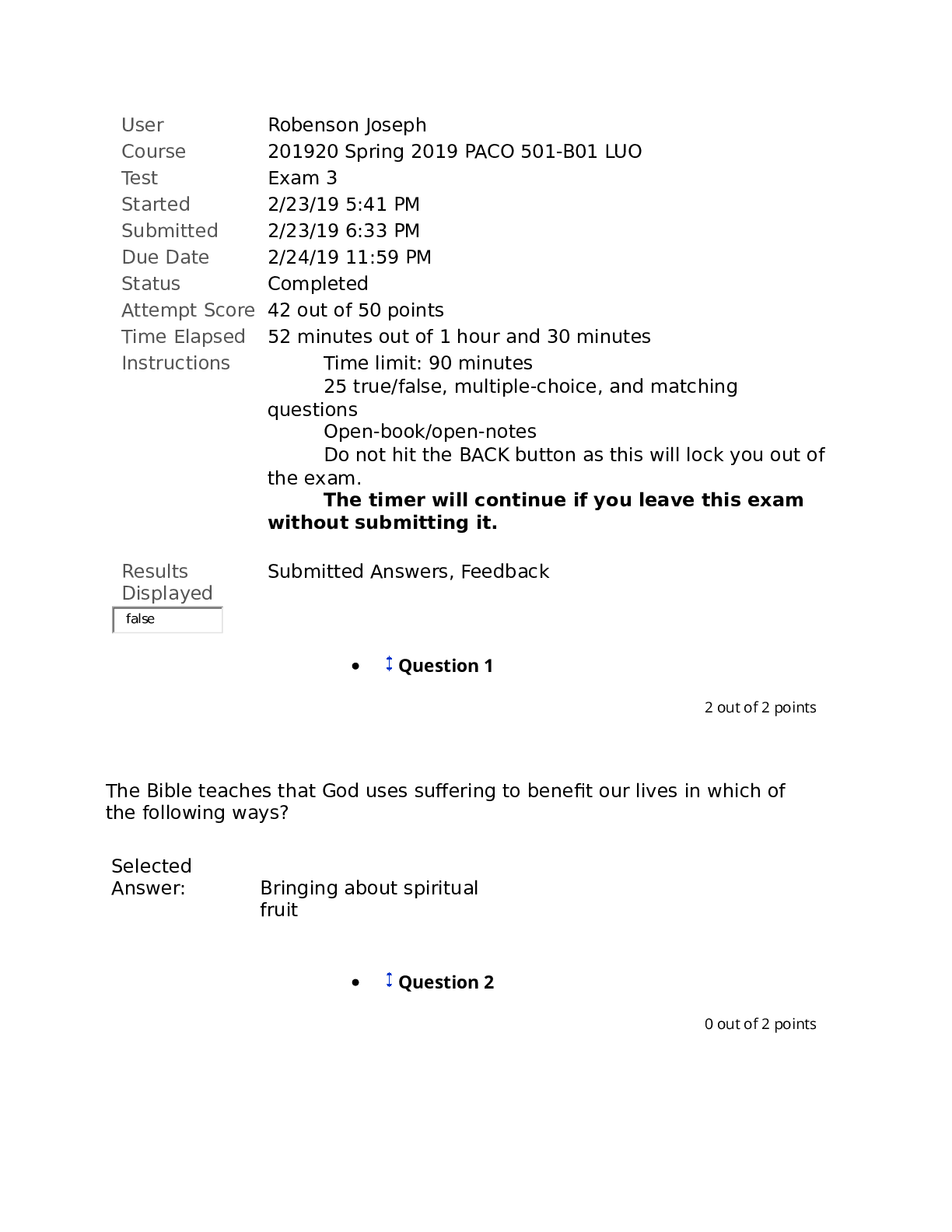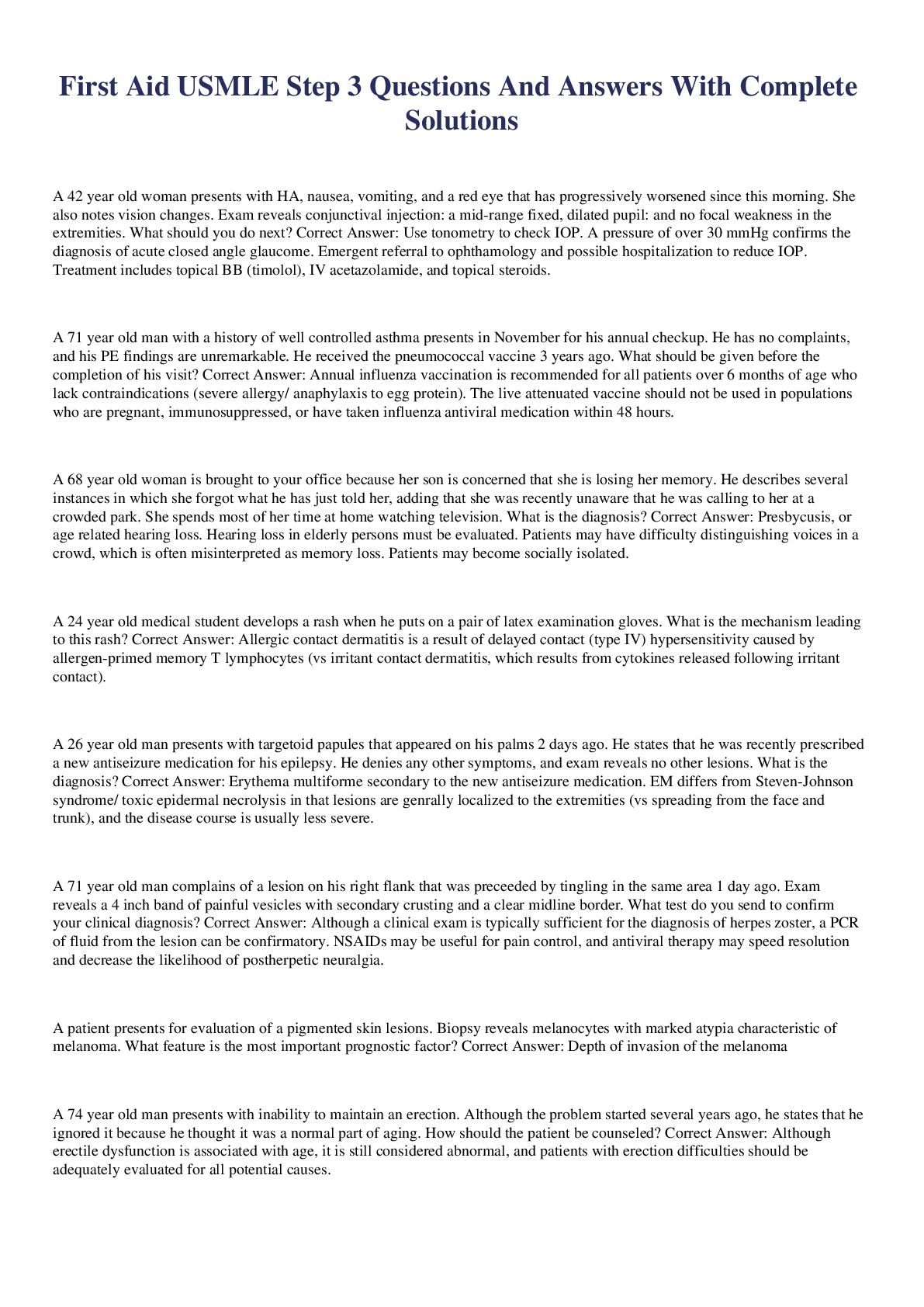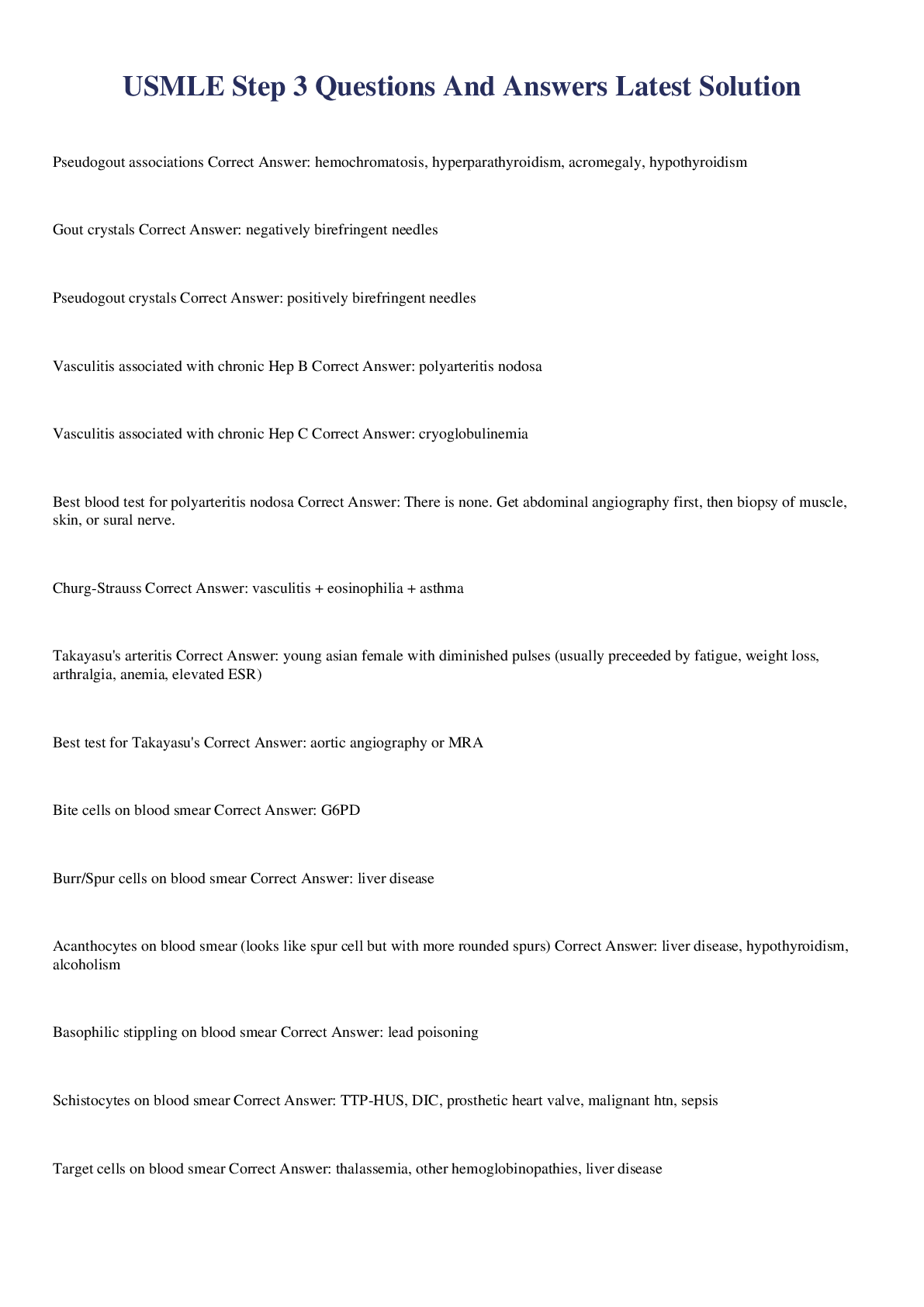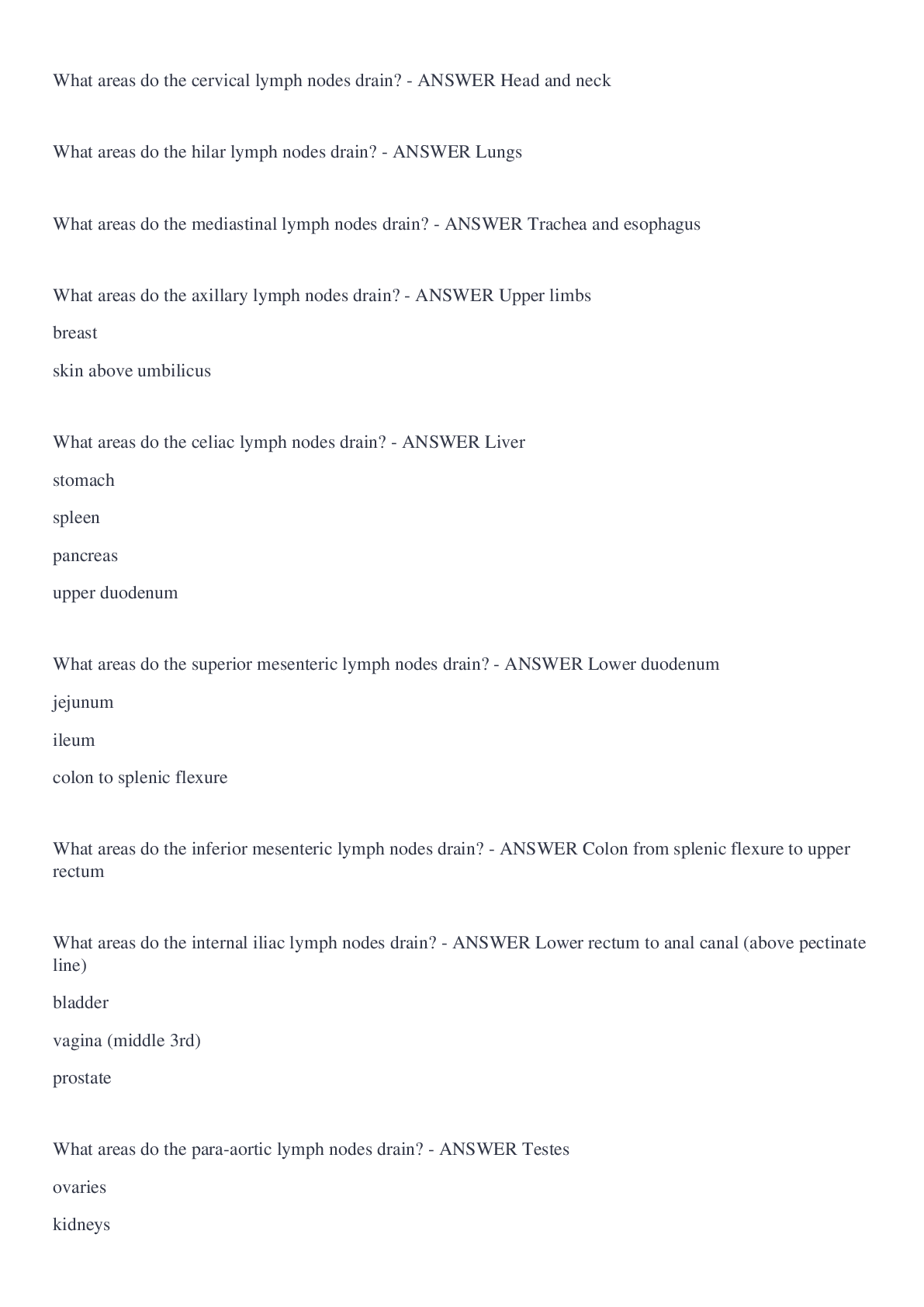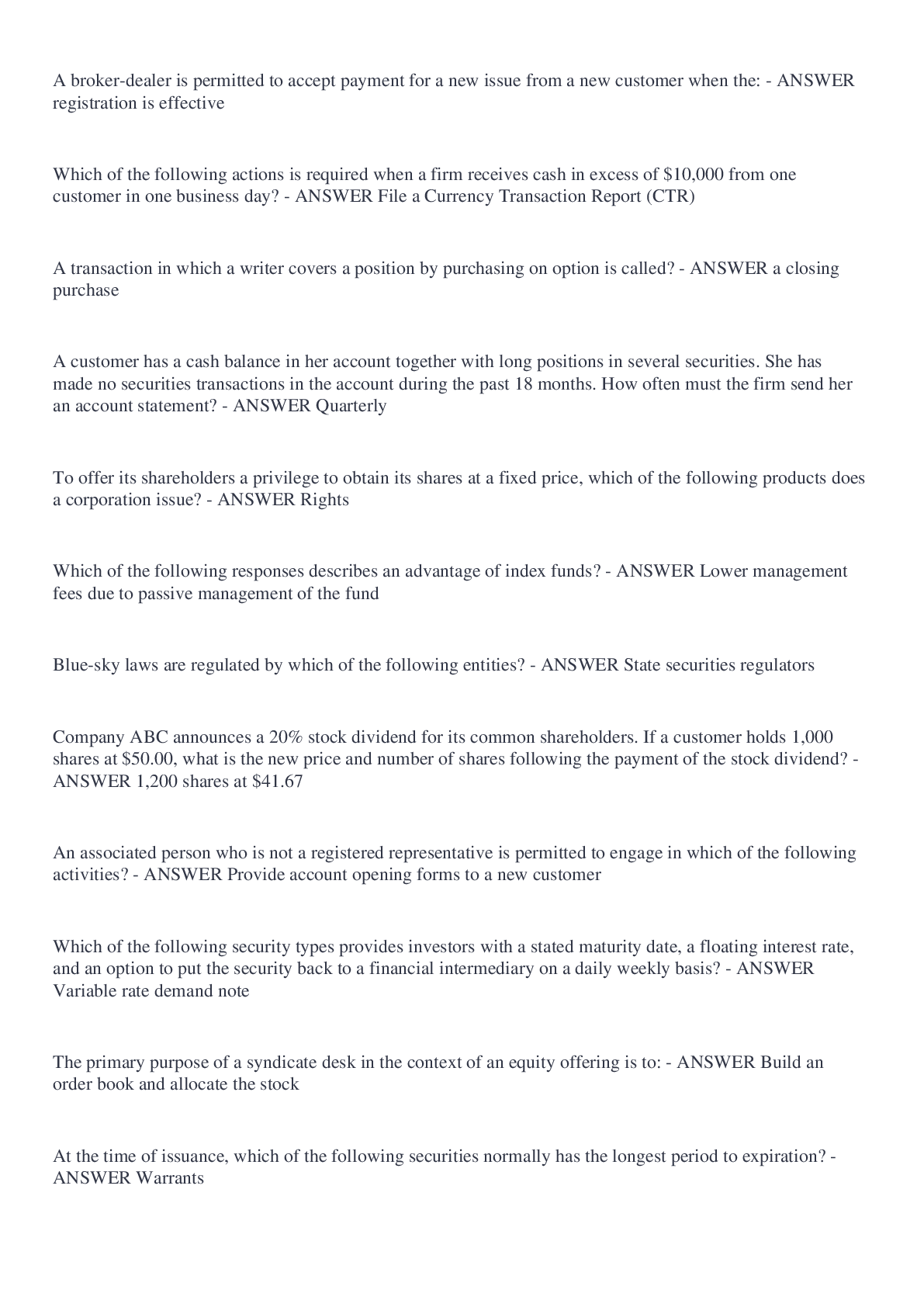NGR 6619 Barkley Study Test 3 Questions And Answers 2022/2023
Document Content and Description Below
Exam 3 1. You are starting your shift after a 56 y/o male pt, Daniel, has been admitted to the ICU for DKA. Already exhibiting confusion and irritability. His blood gases are pH=7.28, pCO2=33. HCO3=... 22, Na=158. Vital signs are; BP=101/53, temp 99.0, pulse28. He has been on isotonic fluids for an hour, but his blood glucose reading is 550 mg/dl. What would be the best IV solution infusion for this pt at this time? a. ½ NS b. Bicarb drip in ½ NS c. 0.9% NS d. 5% dextrose in ½ NS 2 . A 50 y/o male presents with a variety of urinary complaints that include, dribbling, hesitancy, urgency and nocturia. He states that he is awakened at least three times each evening because of his symptoms. In his initial work up, the patients, UA is negative for infection, and his prostate specific antigen level is 3.2. At this time, the next appropriate test or exam to order would be which of the following? a. MRI b. Transurethral US c. CT scan of the pelvis d. Kidney, ureter and bladder x-ray. 3. A pt had his appendix removed and is now experiencing post op fever. Which of the following management options should be initiated for this pt? a. antibiotic regimen b. supportive fluid therapy c. have the pt go on a post op diet d. D/C all medications as this is an allergic reaction to treatment 4. A 63 y/o Caucasian comes to the clinic for a check up and a BP of 125/80 is noted. The examination reveals nothing remarkable. His history is also unremarkable. The NP checks his bp before he leaves and notes a bp of 120/82. Of the following, which must the NP include for treatment? a. CCB b. schedule pt for exercise stress test c. advise therapeutic lifestyle changes d. prescribe ACE inhibitor 5. a 20 y/o male is brought into the psychiatric ward after threatening his family with violence. He is very volatile and is indicating that he may harm himself is left alone. For this reason alone, discharging the patient is not an option, if the NP were to discharge the pt, however, and he then harmed himself or someone else, who would be liable? a. the NP b. the department physician c. the hospital d. the hospital security personnel 6. A pt with a family history of chronic lung conditions comes to your office. He is active, eats healthy, and is not a smoker, however, he thinks he may have asthma and wants to understand the condition. Based on typical disease categorization, asthma is classified as a. restrictive b. obstructive c. mixed d. neither 7. the first practitioner programs were initiated, primarily, because of what issues in health care at the time? a. pediatric physician shortages b. indigent pt needs c. managed care d. hospital restructuring 8. An elderly pt takes an herbal root to help fight cold symptoms; however, he has a history of renal insufficiency. Of the following, which could result from the pts condition and his homeopathic treatment? a. ginseng counteracting warfarin b. Echinacea causing nephrotoxicity c. ginger causing renal insufficiency d. Echinacea causing anaphylaxis 9. an elderly female patient presents with complaints of extreme thirst, lightheadedness, and loss of appetite. The NP orders a series of lab tests to further evaluate the condition. The tests reveal few hyaline casts noted, normal urinary sediment, specific gravity 1:020, urine Na levels of 18 mmol/dl, fractional excretion of sodium lees than 1, and serum blood urea nitrogen to creatinine ratio of 12:1. These findings lead the NP to diagnose. a. post renal failure b. intra renal failure c. intrinsic renal failure d. pre renal failure 10. A middle-aged female is evaluates for complaints of pain during urination and blood in her urine. The NP orders both urinalysis and x-rays to be taken. The NP suspects nephrolithiasis and knows that the type that occurs mostly in women is: a. uric acid b. calcium c. cysteine d. struvite 11. which of the following diagnoses usually presents with a low-pitched diastolic rumble in the left lateral position and typically does not radiate? a. mitral stenosis b. mitral regurge c. aortic stenosis d. aortic regurgitation 12. which aspect of a patients history would put him or her at risk for hepatitis? a. heavy alcohol use b. long history of smoking c. diet high in fats d. gallbladder disease 13. Laura is 61, is hospitalized for symptoms of weakness and dizziness. Her daughter, who brought her in, states that her mother had stood up after a meal and closed her eyes briefly, seemingly causing her to lose balance. You test this again and elicit the same response. Suspicious, you then, rub the back of the patients foot with the back of your pen, to which your patient responds by extending her big toe upwards while her other toes curl outwards. You would expect to see changes in the patients lab values except; a. hemoglobin b. mean corpuscular volume c. serum B12 d. serum ferritin 14. a pt comes to your urgent care facility complaining of headaches, his wife says that she thinks he may have had a seizure in the care while on the way over to your facility. Which of the following tests is most important in determining if the pt experienced a seizure and its type? a. computed tomography scan b. serum prolactin levels c. magnetic resonance imaging d. electroencephalogram 15. of the following conditions, which is not usually associated with anemia of chronic disease? a. HIV b. ulcerative colitis c. systemic lupus erythematosus d. chronic obstructive pulmonary disease 16. A pt with signs and symptoms of abdominal distention, weakness, and occasional diarrhea comes to see you. His history indicates that he has renal failure. You conclude that the pt has a fluid and electrolyte problem. Which of the following is the problem that the pt is most likely experiencing? a. hypercalcemia b. hypocalcemia c. hypernatremia d. hyperkalemia 17. which of the following is recommended for asthmatics or smokers between the ages of 19 and 64? a. hepatitis A vaccine b. pneumococcal vaccine c. hepatitis B vaccine d. meningococcal vaccine 18. What is the leading cause of death of Hispanics in the US? a. cancer b. diabetes c. CVA d. heart disease 19. A 38 y/o female patient of yours has been immobilized for four months. Examining her before release, you note that dyspnea and tachycardia have occurred. You suspect pulmonary embolus, but a ventilator/perfusion scan does not confirm the diagnosis. What is the best next step? a. a second lung scan b. test arterial blood gas c. pulmonary angiography d. spiral computed tomography 20. Jonathan 62, is brought into the emergency room with complaints of lightheadedness. The pt states that he also experienced chest pain, as if something heavy was on his chest. When asked what he was doing before the onset of pain occurred, he states I was taking my usual walk. A physical examination reveals pulmonary crackles and an S4 heart sound. His electrocardiogram results indicates ST elevation in leads 1, aVL, V5 and V6. Of the following, which is this pts most likely condition? a. exertional angina b. inferior wall MI c. anterior wall MI d. lateral wall MI 21. Evan, 37, is in the ER. An endotracheal intubation was performed on him two days prior and he now exhibits fever, chills, and purulent sputum. A chest xray reveals lung infiltrates. Which of the following regimens in best indicated for this patients most likely condition? a. cefepime and Cipro b. ceftriaxone and pcn c. vanco, ampicillin-sulbactam and azithromycin d. tetracycline 22. a concerned adult child of your elderly patient tells you that her father recently threatened to commit suicide. She is very concerned since her father is a heavy drinker and has a history of depression. What would be the best way to manage this situation? a. tell the pt that 5% of depressed people commit suicide b. tell the pt that suicide incidents decrease with age c. tell the pt that alcohol abuse does not increase the risk of suicide d. tell the pt to hospitalize her father and have him receive psychotherapy tx 23. Henry, 62, is in your care for angina. He first experienced his symptoms some weeks ago while taking a walk. His labs reveal his low density lipid levels are 250 mg/dl, hdl is 25 mg/dl and total cholesterol is 350 mg/dl and triglycerides are 250 mg/dl. The management regimen prescribed to him includes counseling on diet and reduction of health risk factors and niacin. He states isn’t niacin in some energy drinks? How will this help me? To which you respond by stating? a. niacin can shorten or prevent the onset of chest pain that occurs due to angina b. niacin is common pharmacological therapy for treatment of angina c. niacin provides energy to maintain a more active lifestyle d. niacin will reduce low density lipid levels while increasing HDL levels 24. which of the following is neither a cause nor a factor for increasing the risk of a mesenteric infarct? a. atherosclerosis b. smoking c. venous thrombosis d. volvulus 25. You are counseling a patient who was recently diagnosed with Alzheimer’s disease. Which of the following statements is true regarding this disease? a. there is demyelination of peripheral nerves due to an inflammatory poly neuropathy b. there are a reduced number of acetylcholine receptors sites at the neuromuscular junctions c. there is an imbalance of dopamine and acetylcholine in the corpus stratum d. incidence of Alzheimer’s is typically associated with a lack of overall acetylcholine in the body. 26. Mr. Roth, a 54 y/o male, complains of abdominal pain, especially when he eats. How should his localization of pain be classified? a. cutaneous b. somatic c. visceral d. neuropathic 27. you have just been certified as a NP and are out to lunch with your grandmother, who has been an NP for over 40 years. You ask her for advice and she says the only thing you can do is to always try to improve, much in the same way that the continuous process improvement (CPI) continually adjusts the systematic approach of the healthcare profession. CPI uses three measurements to measure improvement, which are structure, outcomes and.. a. processes b. indicators c. standards d. compliance 28. You are treating a high school student who was recently hospitalized for internal injuries sustained in a school bus accident and underwent an emergency blood transfusion to save her life. She now comes to your office complaining of blood in her urine and describes periods of nausea, itching, and intense headaches. Given this information, the NP considers the possibility of a mismatched blood transfusion. This error would most likely put the pt at a particular risk for developing which class of acute renal failure? a. postrenal b. intrarenal c. prerenal d. mechanical 29. Which of the following drugs listed can cause a lupus-like syndrome? a. aspirin b. propranolol c. procainamide d. sertraline 30. the nurse practitioner is evaluating an elderly pt for a UTI. The pt has no history of this condition, however, she has been diagnosed with sickle cell disease. While the pts symptoms indicate a UTI, it has not been determined which type is present. Which of the following symptoms will most reliably distinguish an upper UTI with a lower UTI? a. flank pain b. urgency c. nocturia d. N/V 31. Suspected cases of elder abuse not only involve physical violence but also negligence and exploitation, among others. Which of the following scenarios could sometimes not fit the definition of elder abuse? a. caregivers consistently failing to provide the proper medications to the pt b. restraining an aged, mentally-ill pt against his or her will c. a family member forcing his Alzheimer’s afflicted father to sign documents d. caregivers consistently failing to meet special dietary requirements of the pt. 32. your elderly pt, Jim, has been diagnosed with hyperthyroidism. After informing him, he explains to you that he is not all that concerned because his brother also has that condition and he has been fine. You tell Jim that hyperthyroidism can be asymptomatic, but it may also cause a number of problems. Which of the following is a complication of this disorder? a. myxedema coma b. thyroid crisis c. weight gain d. thyroid cancer 33. Erin 52, Is admitted to your hospital with complaints of headaches, lightheadedness, and overall feeling of weakness. The patient is hardly able to walk. When asked to stand up, the pt stated she had a head rush and needed to immediately sit down. Upon physical exam, you note the pts heart rate is 120 bpm. Subsequent blood work indicates her hemoglobin is 9g/dl, hematocrit 28%, mean corpuscular volume is 70 fl, mean corpuscular hemoglobin concentration is 20 pg, total iron binding capacity is 610 ug/dl. Of the following conditions which is the patients most likely diagnosis? a. thalassemia b. pernicious anemia c. iron def anemia d. vitamin B12 def anemia 34. An elderly woman who has a history of lung dysfunction comes to your office. She presents with a number of respiratory symptoms, but one of her main complaints is of a severe headache. Which of the following conditions is most likely to present with this accompanying symptom? a. asthma b. acute bronchitis c. pneumonia d. emphysema 35. Tim is 19 and was brought to the ER with fever and abdominal pain that started yesterday. Upon physical exam you note tenderness and guarding to the right lower quadrant with pain accompanying extension and internal rotation of the right thigh. Tim’s temperature is 100.4 and a cbc shows leukocytosis with a shift to the left. Which of the following would best confirm your differential diagnosis of appendicitis? a. abdominal ultrasound and WBC of 10,000 to 20,000 mcl b. abdominal CT and elevated amylase c. abdominal ultrasound and sigmoidoscopy d. abdominal CT, serum amylase 180 U/dl and lipase 280 U/L 36. Hal 32, presents to your clinic with complaints of fever, night sweats, and unexpected weight loss. Upon physical exam, you note a swollen cervical lymph node. A subsequent chest x-ray reveals mediastinal adenopathy. Of the following, which is this patients most likely diagnosis? a. lung cancer b. hodgkins lymphoma c. tuberculosis d. mononucleosis 37. A young pt who fell off his skateboard complains of pain in his ankle. The patient had sprained his ankle four hours prior while doing skateboard tricks. As the NP, you should chart the type of pain this pt is experiencing as: a. somatic b. visceral d. cutaneous d. neuropathic 38. A pt is experiencing heart failure. After checking on the pt, you determine that the pt has a valvular disease due to mitral regurgitation. Which of the findings below would best indicate that the pt has mitral regurgitation? a. loud s1 murmur b. s3 with systolic murmur c. systolic with harsh murmur radiating to the neck d. diastolic murmur at the 2nd intercostal space 39. Which of the following is not a finding of pheochromocytoma? a. normal TSH level b. metanephrine levels >1.4 pmol/ml c. plasma concentration of normetanephrine >2.5pmol/ml d. adrenal insufficiency 40. a patient of yours is in the ER because he experiences a sudden loss of consciousness and motor function. The NP in the ER diagnosed him with TIA. The NP tells you that the pt is experiencing right handed weakness and numbness. Carotid studies reveal that both the left and right carotid arteries are approximately 92 to 95% occluded. Which of the following statements is true regarding this pt? a. the left carotid will be explored, and the team will want to see if there is improvement, if so the pt will be medically treated with medications administered orally. b. the right carotid will be explored first, with left carotid exploration at a later date. c. the right carotid will be explored and the team will want to see if there is improvement, if so, the patient will be medically treated with oral medications. d. the left carotid will be explored first with right carotid exploration at a later date. 41. Larry, 34, recently immigrated into the US from Thailand. He tells you that his mother sometimes had episodes of lightheadedness that were so severe that she would sometimes be unable to get up. She was never properly diagnosed with any condition and would like to see if he may have a disorder that may be responsible. You know that Thalessemia may possibly cause symptoms such as his mothers and that people from Asia are particularly at risk for this disorder. You order blood work, which would most likely indicate Thalassemia if the labs showed which of the following results? a. Hgb 14, MCV 100, MCH 36%, TIBC 300 b. Hgb 10, MCV 150, MCH 31%, TIBC 250 c. Hgb 9, MCV 70, MCH 21%, TIBC 610 d. Hgb 8, MCV 62, MCH 29%, TIBC 320 42. You are monitoring the progression of a patients HIV infection using viral load testing. The ideal viral load result for HIV pts is which of the following? a. greater that 4,000 b. less than 5,000 c. greater than 6,000 d. less than 6,000 43. An Asian female pt with fever and chills is convinced she has a UTI. She tells the NP that she had this condition 2 years ago, and she feels it has returned. The NP knows that the most common pathogen associated with UTI in women is: a. E. Coli b. Proteus species c. Enterobacter d. Staphylococcus 44. After a 57 y/o pt fainted while working, he is admitted to your hospital. You perform a number of tests, including BP, Na level, and K level. Some of his lab findings include urine Na of 28, serum osmolality 250, and urine osmolality 115. Of the choices, which of the following could have caused the patients current lab results? a. DI b. SIADH c. Polyuria d.Tachycardia 45. You are conducting a follow-up exam on a pt who recently received a kidney transplant. The pt has chills and reports feeling tired all the time. You also note a fever. Eventually, you suspect pneumonia. All of the following findings would typically confirm such a diagnosis except: a. hypotension b. elevated WBC count c. infiltrates on CXR d. purulent sputum 46. A 73 y/o female presents with dizziness, palpitations, and an appetite appearance. The pt also complains that she frequently feels weak and tired and loses motor control as well. Lab testing shows a MCV of 110, Hgb 10, Hct 30. Which of the following is the likely diagnosis? a. Iron def anemia b. pernicious anemia c. anemia of chronic disease d. folic acid deficiency 47. A 45 y/o pt comes to your office complaining of pain in his wrist and hands. A physical exam reveals that the areas of complaint are red and swollen. Additionally, the pt mentions that his symptoms are worse in the AM but get progressively better as the day continues. Which of the following would be a typical finding of this pt most likely condition? a. narrowing of the joint space b. osteophytes c. elevated ESR d. juxta-articular sclerosis 48. Once a pt is diagnosed with compartment syndrome, a pt should immediately receive which of the following? a. sun protection b. physical therapy c. pressure patch d. referral for surgery 49. your pt is actively limiting his cholesterol intake and committing to regular screenings in response to elevated numbers in his blood work. He also aims to ensure prevention of the development of any unexpected condition. Which form of prevention is your pt practicing? a. Primary prevention b. Ancillary prevention c. Secondary Prevention d. Tertiary Prevention 50. A pt calls your office to complain about the invoices he has been receiving for his regular check ups. He angrily explains to you that he has Medicare C coverage, which should cover all costs incurred. You should respond by explaining that: a. since you are healthy, your exams are not covered b. you must have received the invoices by mistake c. you should talk to medicare to have the invoices paid d. physical exams are always billed to pts 51. Melvin, 55, y/o is admitted to the ICU for hypotension. A pulmonary artery catheter is placed with the following readings. Cardiac index 2.0, PCWP 3, SVR 1500, BP 80/60 and HR 120. Which of the following types of shock do these findings indicate? a. cardiogenic b. hypovolemic c. distributive d.septic 52. You are beginning work at a new hospital in your new town, New Orleans. One of your primary concerns is the development of proper pt-nurse relationships. You want to make sure that you never abandon your pt and that you properly terminate your pt relationships. All of the following should be a part of terminating a pt-nurse relationship except: a. reasonable notice b. refusal of assignment c. admission of lack of competence d. referral to a different practitioner 53. A patient arrives to the nursing unit after being turned in an explosion at work. His burns feature moisture on the skin with blisters and redness. As a NP, you conclude that the pt has 2nd degree burns. The pt wants to know how much of his body has been burned. You notice that only his arms, neck and face have been burned. Which of the following would be the most accurate answer to the pts question? a. 9% b. 18% c. 28% d. 38% 54. Which of the following findings is exclusive only to cardiogenic and one other type of shock, helping the NP differentiate from other forms of shock states? a. consistently low cardiac index b. consistently high central venous pressure c. consistently high systemic vascular resistance d. consistently low mixed venous oxygen saturation 55. A 56 y/o male with history of alcoholism and diabetes presents to the office for a check up. The nurse practitioner notes mild azotemia with 75% nephron loss. The patients stage of renal insufficiency would be correctly categorized as: a. renal insufficiency b. post renal disease c. diminished renal reserve d. end stage renal disease 56. Which of the following is the most accurate paraphrase of the American Nursing Associations social policy statement? a. collaboration is a true partnership in which all actions share common goals and accept accountability b. competition is the best means of achieving the best pt care c. a NPs duty is to do now harm, be fair, and truthful d. the right act is the one that produces the most good for the greatest number 57. An 18 y/o female is bitten by a spider while she is hiking with a friend. She is brought to the emergency department after having a severe allergic reaction to the venom. Which of the following is not a treatment the NP could use to treat the pts most likely condition? a. diphenhydramine b. nitroglycerin c. inhaled beta agonists d. crystalloids 58. A mother comes to your office with her 19 y/o son, who was stung by a bee and has subsequently developed respiratory distress, stridor, and faintness. As the NP, which of the following should you immediately administer to the pt? a. epinephrine b. crystalloids c. inhaled beta agonists d. vasopressors 59. A pt incurred severe head trauma after a motor vehicle accident. Upon admission, the pts vital signs are Temperature 98.9, BP 132/60, pulse 126, RR 21. One hour after admission, the acute nursing care professional notes the presence of Cushings triad if the pts vitals signs are: a. BP 140/60, pulse 70 and RR 14 b. BP 132/72, pulse 130 and RR 28 c. BP 120/90, pulse 105 and RR 15 d. BP 110/70, pulse 120 and RR 30 60. your 30 y/o pt has come to the clinic, sweating and very anxious. He has been vomiting and reports severe epigastric pain. Upon physical examination, you note discoloration in the flank and the umbilical region. Which of the following findings is the most expected in this patient/ a. Leukopenia b. hypoglycemia c. elevated serum lipase d. bradycardia 61. you have a pt who presents with a number of respiratory symptoms. He has a temperature, and you hear crackles upon auscultation. You believe your pt has either pneumonia or acute bacterial bronchitis. Which of the following signs or symptoms would confirm a diagnosis of pneumonia? a. consolidation in the lungs b. chills c. purulent sputum d. malaise 62. An elderly male presents for a routine check up with the NP. The pt has a high BP and a history of diabetes but shows no physical signs of renal failure, however, the NP reads on the pts chart that he nephrologist diagnosed him with a diminished renal reserve. Which of the following is the most expected finding in this pt? a. 25% nephron loss with mild azotemia b. 50% nephron loss with doubled creatinine c. 75% nephron loss with mild azotemia present d. 90% nephron damage, azotemia and mild metabolic alterations 63. 50 y/o Raymond comes to your office complaining of severe pain in his eye. Raymond also states that his vision has become blurred and that he has begun to see halos. Moreover, you note that Raymonds pupils appear to be dilated. To treat the most likely diagnosis, you would prescribe all of the following except: a. carbonic anhydrase inhibitors b. acetazolamide c. alpha 2-adrenergic agonists d. osmotic diuretics 64. The NP is evaluating the laboratory findings of a woman suspected to have intrarenal failure. The pt has a history of hypersensitivity(allergic disorders) and is currently unable to urinate. Which of the following is not an expected finding in a pt with intrarenal failure? a. specific gravity <1.015 b. urinary sediment with granular white casts c. fractional excretion of sodium >3 d. urine sodium <20 mmol/dL 65. A friend, who is a fellow health care worker, has become infected with TB. You want to be a good friend as well as a good nurse. As a friend, you comfort and calm her. As a nurse you know you have to start your friend on a regimen of which medications? a. Rifampin and isoniazid b. rifampin and pyrazinamide c. isoniazid and streptomycin d. pyrazinmide and isoniazid 66. There are many drugs that can be used to treat hypertension, each with their own mechanism of action and side effects. Of the following, which of these is an inaccurate statement concerning the drugs mechanism of action and/or side effect? a. enalapril decreases heart rate, BP, and myocardial oxygen demands b. nitroglycerin decreases venous return and myocardial oxygen requirements c. verapamil decreases myocardial contractility and systemic vascular resistance d. Ramipril may cause cough and/or bronchospasm as a side effect 67. your pt comes to your office to receive the results of her Pap smear test. The results are negative, and she has gone ten years without any abnormal results. You tell her that she no longer needs to receive Pap tests. Within which range must your pt be? a. 55-60 b. 60-65 c. 65-70 d.70-75 68. Margaret was brought into the ER for complaints of chest pain and dizziness. The ambulance conducted a pre hospital ECG that revealed ST elevation greater than 0.1 mV in leads II, III and aVF. Margarets history indicates that this is the first thrombolytic event she has experienced. When should fibrinolytic therapy be initiated in this pt, if indicated? a. within 30 minutes of admission to the hospital b. within 60 min of admission to the hospital c. within 90 min of admission to the hospital d. no indication for fibrinolytic therapy in this case 69. A 29 y/o male patient is admitted to the ER with severe abdominal pain in his RLQ. He reports that the pain has worsened over the past three days and has avoided care in hopes that the pain would resolve on its own. He reports nausea, fever, and diarrhea. He is supine on the exam table with his right leg drawn towards his chest, and your physical exam reveals a tender abdomen with positive psoas sign. Based on this clinical presentation, you suspect the diagnosis is: a. diverticulitis b. cholecystisis c. appendicitis d. ulcerative colitis 70. A 67 y/o pt comes to your office and is showing signs of giant cell arteries. Which of the following would not be a finding expected in this pt? a. normal white blood cell count b. very high erythrocyte sedimentation rate c. positive temporal artery biopsy d. inflamed synovial synovium 71. Steven, 47 y/o comes to your office complained of intense pain in his right eye, which has worsened since he woke up this morning. When you perform an eye exam you find that he has copious amount of tearing and redness in his right eye. Which of the following would confirm the most likely diagnosis? a. tonometry b. arteriovenous nicking c. synovial aspirate d. sodium fluorescerin stain 72. Mr. Garcia’s friends brought him to the ER for an overdose. His signs and symptoms include nausea, vomiting, dizziness, headache, and dehydration. The pts friends tell you that they found an empty bottle of aspirin next to him at the apartment. Of the following, which would be the best management for this patient? a. charcoal administered orally via orogastric tube b. washing skin thoroughly c. administering acetylcystine d. use of naloxone 73. A 48 y/o female is admitted with fever, abdominal pain and bloody diarrhea. Her history includes chronic sinusitis, arthritis, and a recently resolved DVT, however, her current signs and symptoms are happening to her for the first time, especially her bloody diarrhea. Which of the following represents the most likely diagnosis and the appropriate test to order? a. diverticulitis, sigmoidoscopy b. diverticulitis, stool culture c. ulcerative colitis, sigmoidoscopy d. ulcerative colitis, stool culture 74. After reviewing the annual physical results of your middle aged pt, you advise him that he should now begin receiving a colonoscopy every ten years. At what age would your pt be to begin receiving colonoscopies? a. 45 b. 50 c. 55 d.60 75. After discovering H. Pylori and GI bleeding, you diagnose your pt, a 54 y/o male, with a bleeding duodenal ulcer. His blood work indicates his Hgb is 12.2 g/dL, and Hct 34%. Which of the following interventions is the best management for this disease? a. start a vasopressin drip at 0.2 units/minute b. transfuse four units of PRBCs c. broad spectrum antibiotics d. start an esomeprazole drip at 20 mg/day 76. what is recommended percentage of total energy intake in the form of carbohydrates? a. 50-55% b. 55-60% c. 60-65% d. 65-70% 77. At 9 am, a male pt is brought into the ER by ambulance after being in a fiery auto accident an hour earlier. He has full thickness burns over his back, buttocks, and both lower extremities. His weight on admission is 264 lbs. At 6 pm, the day shift NP gives report to the night shift attending physician. Using the Parkland formula, what volume of fluid should have been administered to the pt by the time of shift change? a. 14580 ml b. 14175 ml c. 13770 ml d. 12960 ml 78. Graves disease is the most common presentation of what endocrine disorder? a. hypothyroidism b. hyperthyroidism c. cushings syndrome d. addisons disease 79. Of the following pts, who would most likely have emphysema? a. A 42 y/o who is stocky and has intermittent mild to moderate dyspnea b. A 59 y/o with an increased anteroposterior chest diameter c. A 47 y/o with air pockets on his CXR d. An emaciated 61 y/o pt with copious, purulent sputum 80. You are checking heart sounds in a patient who has a history of cardiovascular issues and hear a Kentucky gallop during auscultation. Which of the following heart sounds is associated with an audible Kentucky gallop? a. S1 b. S2 c. S3 d. S4 81. A patient has been administered a Tdap vaccine. Which of the following terms best represents what this patient has received or undertaken? a. active immunity b. secondary prevention c. passive immunity d. tertiary prevention 82. Kelly presents with episodes of constipation that alternate with episodes of diarrhea. She complains of mild abdominal pain. A physical exam indicated the pain is in the LLQ, hypoactive bowel sounds and mild fever. A sigmoidoscopy indicates inflamed mucosa. Conservative treatment for the pt includes all of the following except: a. high fiber diet b. antibiotic therapy c. barium enema d. aspirin 83. Jack, 52, is brought into the trauma unit after experiencing an MI. The pt is currently receiving dopamine, dobutamine, norepinephrine, and nitroglycerin. The patients BP was at 105/71 but suddenly drops to 81/52. Which of the following indicates the most correct action to take at this time? a. decrease the rate of norepi b. decrease the rate of nitro c. decrease the rate of dobutamine d. decrease the rate of dopamine 84. Which of the following is true about AIDS? a. modes of transmission are similar to those of hepatitis B b. It is transmitted through blood, semen, sweat, and breast milk c. modes of transmission are similar to those of hepatitis A d. risk of HIV infection via needle stick is approximately 1.450 85. Your 45 y/o pt is concerned that she is losing physical strength and alacrity, and she has come to you for advice on beginning an exercise regimen. The pt cannot commit, however, to a strenuous program at this time. The American heart association recommends that adults should exercise for how long on most days of the week/ a. at least 15 minutes b. at least 20 minutes c. at least 30 minutes d. at least 45 minutes 86. Your pt presents with night sweats and a dry cough. After the exam, you discover that he has lost a significant amount of weight since the last time you saw him. You suspect the pt has TB. Which of the following would be the most definitive in the diagnosis of this condition? a. culture b. acid fast bacillus smear c. purified protein derivative d. CBC 87. According to a new pts chart, he has a history of status epilepticus. In the middle of your routine exam, he experienced a seizure that lasts about 12 minutes. Which of the following drugs would best stabilize the pt? a. fosphenytoin b. diazepam c. valporic acid d. phenobarbital 88. which of the following is not an occasion in which a pt should receive a catch up for the meningococcal vaccine? a. entering high school b. entering college c. entering the military d. traveling to Africa 89. A pt with emphysema is in the hospital for tx. He tells you that he is always sleepy, feels confused, and that sometimes, some of his muscles twitch. His arterial blood gas labs indicate that his pH is 7.32 and pCO2 47. You suspect that the pt has respiratory acidosis and begin ventilator support. Which of the following is not an advisable tx option for respiratory acidosis? a. naloxone for all pts with no obvious cause b. improve ventilation and intubate if necessary c. raise rate of ventilator d. decrease rate of ventilator 90. A 66 y/o pt comes to your office. The pt has fever and is complaining of chills, scalp tenderness, and pain in his jaw, which is worsening his headache. He was prescribed prednisone for treatment of his condition, giant cell arteritis. His signs and symptoms have since subsided. Which of the following most accurately states the reason for why the pts condition has been alleviated? a. the prednisone weakened the pts immune system, thus stopping the immune system from attacking the pts body and thereby alleviating s/s b. the prednisone reduced the inflammation associated with the pts condition, thereby alleviating s/s c. the prednisone decreased the activity of the pts overactive thyroid, thereby alleviating s/s d. the prednisone decreased the activity of the pts underactive thyroid, thereby alleviating s/s 91. Of the many objectives of Healthy People 2020, which of the following is not one of them? a. availability b. privacy c. quality care d. cost 92. A pt comes to your office complaining of a fever and chills. You are about to begin a routine checkup with a pt when he interrupts you to ask about your health insurance policies. He says that he has been turned away in the past by different NP because he did not have Medicaid. He asks you what your offices policy is. You should tell him that it is not the decision of the health care professionals, rather, Medicaid pays: a. when pts contributes 20% of costs b. after other insurance or third party payments have been made c. when pts do not have enough income to cover the cost of healthcare d. when pts are in life or death cases and/or ER visit 93. During a routine exam, your pt collapses. You revive and stabilize him, then refer him for an overnight stay in your hospital for further observation. Out of the following, which service would qualify as incident to billing? a. the overnight hospital stay b. weighing him and taking his temperature c. the initial office visit d. the subsequent follow up exam 94. Tom 36 y/o has Crohn disease and arrives at the ER complaining in his belly, frequent vomiting and watery bowel movements. You notice high-pitched, thinking bowel sounds during examination, and a trans abdominal ultrasound reveals a partial small-bowel obstruction. Which of the following interventions is not necessary at this time? a. Nothing by mouth and IV fluids b. Nasogastric tube to low wall suction c. Immediate referral for surgery d. monitor pt for spontaneous resolution 95. Studying data on the incidence of lung disease in a small Virginia mining town, you notice that the standard deviations among individuals are notably large in this town when compared to incidences in the state as a whole. What does this fact tell you about the rates in this Virginia town? a. There is little difference among local rates b. the mean, median and mode are approximately the same c. local incidence varies widely from the mean d. rates vary widely among the population in this town 96. A pt comes to the ER for injuries sustained as a result of domestic violence. The pt was emotionally distraught but has since calmed down. During the interview, you notice that she has a handgun in her purse, she says she took the gun to hide from her husband. Which of the following is the best course of action? a. call the police to report a dangerous pt b. call social services to report spousal abuse c. call hospital security to ensure safety d. remove the firearm from the pts possession 97. Your pt is receiving enteral nutritional support when complications start to arise. As a NP, you would most likely see all of the following as a complication of enteral nutritional support, except: a. Aspiration and/or vomiting b. diarrhea c. catheter sepsis d. dehydration 98. you have a pt who is “a starving artist” He lives in an apartment with six other people and has come to you presenting with a number of symptom. He has a high fever and purulent sputum, and physical findings include lung consolidation. Which of the following pathogens is the most likely cause of your patients condition? a. Mycobacterium pneumonae b. klebsiella c. Staph Aureus d. Strep. Pneumoniae 99. When is the earliest age for prostate surface antigen in a non- African-American pt or a pt with no family history of prostate cancer? a. 40 b. 45 c. 50 d. 55 100. Your pt, Hannah, is in your care for treatment of Cushing’s disease. She exhibits a wide range of symptoms including hypertension, weakness, and thirst, among others. Which of the following lab findings would you not expect to see in Hannah? a. hypokalemia b.glycosuria c. hypernatremia d.hypoglycemia Rationales 1. Since the pts BG is over 500 and has already received isotonic fluids for an hour, the pt should receive ½ NS at this time. A bicarb drip in ½ NS is not indicated at this time, because the pts pH does not indicate severe acidosis. If there is severe volume depletion, which this pts normal BP does not seem to indicate, then 0.9% NS should be used. It is when glucose levels fall below 250 that the NP should change the pts IV infusion to 5% dextrose in ½ NS to prevent hypoglycemia. 2. In cases of BPH, a PSA value of 3.2 in a 59 y/o pt is above the average and indicates the need for a transurethral ultrasound to detect changes in the prostate gland. MRI and CT scans of the prostate are used more commonly in the eval of prostate ca, rather than BPH. Kidney, ureter, and bladder xrays are typically used to detect kidney stones and other GI conditions. 3. Initial treatment of post-op fever, infectious or non infectious should include fluid therapy since it provides the daily requirements and helps restore any essential losses. Although the cause of the fever may be bacterial, antibiotics are not indicated until a gram stain and culture and specimen of all invasive lines or catheters are gathered. Initial tx of post op fever should include fluid therapy to address dehydration. Causes of post op fever do not usually occur as a result of a nutritional deficiency, hence, a post op diet is not necessary at this time. Lastly, while drug reactions to medications are certainly one possible cause of post op fever, initially discontinuing all the pts meds is too drastic of a measure at this time and should be considered after infectious and other non infectious causes have been differentiated. 4. Lifestyle changes are recommended to all hypertensive pts, no matter what stage of hypertension they are in. Hypertension is diagnosed only after a sustained elevation of SBP greater than 140 or DBP greater than 90 is noted at least three times on two different occasions, after which medications are then considered, however, this pt exhibits only prehypertensive levels. Further more, antihypertensive drugs are used as sparinglt as possible and should be prescribed concurrent with the initiation of therapeutic lifestyle changes. Lastly, an exercise stress test is the usual test to elicit chest pain in pts with suspected angina and usually has no application in the diagnosis or treatment of hypertension. 5. If a NP discharges a pt who is potentially violent toward him/herself or others, then that NP can be held legally responsible for the outcome. Laws vary from state to state but most require that a potentially dangerous or at risk pt should be involuntary committed to psychiatric care. In this case, the other parties, the department physician, the hospital and the hospital security personnel are not as directly liable for such a pts violent behavior as the N, as these parties did not discharge the pt, the person who discharges the pt makes the judgment that the person is not potentially dangerous and is thus responsible should a lapse in judgment occur. 6. Because asthma causes difficulty while exhaling, it is considered an obstructive lung condition. Asthma, in fact, is one of the most common obstructive lung disorders. A restrictive lung condition on the other hand, causes difficulty with expanding the lungs fully while inhaling air. Mixed conditions cause difficulty exhaling and inability to fully expand the lungs while inhaling. 7. A- physicians shortage 8.Echinacea, a herb used to fight cold symptoms, can cause nephrotoxicity, ultimately leading to worsening renal insufficiency. Ginseng counteracting with warfarin could possibly cause a MI, not renal insufficiency. Lastly, the pt is not experiencing an allergic reaction or anaphylaxis. 9. Patients with prerenal failure present with a serum BUN to creatinine ratio above 10:1, urine Na levels below 20, specific gravity greater than 1.015, a normal urinary sediment with few hyaline casts, and fractional excretion of sodium below 1. These findings are sufficient to diagnose this pt with prerenal failure and rule out the other three types of renal failure. 11.Mitral stenosis usually presents with a loud S1 murmur, low pitched, diastolic rumble with an apical crescendo rumble that does not radiate. Mitral regurgitation typically presents with an S3, systolic murmur that may radiate to the base or left axilla and be musical, blowing or high pitched. Aortic stenosis classically presents with a systolic, blowing, rough, harsh murmur at 2nd right intercostal space, usually radiating to the neck. Last, aortic regurgitation characteristically presents with a diastolic, blowing murmur at 2nd left intercostal space. 12. Heavy alcohol use can inflame the liver, contributing to the development of hepatitis in a patient. Smoking, a diet high in fat, and gallbladder disease, on the other hand, do not directly contribute to the development of hepatitis. 13. The nurse practitioner elicited a positive Romberg and Babinski sign which most likely indicates pernicious anemia, and all of the choices except for serum ferritin would be affected. Lab results indicative of pernicious anemia are decreased Hgb, Hct, serum B12, and increased MCV. 14. An EEG records the electrical activity of the brain, helping to precisely diagnose and classify seizures. Serum prolactin levels can be used to help distinguish types of epileptic seizures, but this screening method is not as useful of the general diagnosis and categorization of seizures as an EEG. CT scans and MRI are used for spotting tumors and monitoring hemorrhaging, which may cause seizures, but do not classify seizures. 15. COPD is not usually associated with Anemia of chronic disease and although this condition is a chronic infection, COPD could lead to increased RBC production due to hypoxemia, this presenting with labs inconsistent with anemia of chronic disease. Anemia of chronic disease if usually associated with chronic inflammation conditions, such as SLE or ulcerative colitis, chronic infections such as HIV. 16. Based on the pts s/s and history, he is most likely experiencing hyperkalemia. Causes of hyperkalemia. Cause of hyperkalemia can include renal failure. Although weakness and diarrhea are symptoms of the other electrolyte problems, abdominal distention helps distinguish hyperkalemia from the choices as this pts most likely condition. 17. for smokers or asthmatics between the ages 19 and 64 years, the pneumococcal vaccine is recommended to prevent pulmonary camplications. The hepatitis A vaccine is recommended to those serving in the military, traveling to endemic regions, and to sexually active homosexual meds. The hepatitis B vaccine is recommended for all healthcare workers and sexually active adults, due to a high risk of sexual transmission. The meningiococcal vaccine is not a regularly recommended vaccine due to questionable cost effectiveness, but is generally administered to adolescents, new college students, military personal and people who frequently travel. 18. When treating Hispanic patients, one fact to keep in mind is the threat of heart disease. Cancer, diabetes, and cerebrovascular accident are also threats, however, the incidence of heart disease of not only the Hispanic population, regardless of ethnicity, is the leading cause of death as well. 19. Pulmonary angiography is recommended when clinical data and the ventilation/perfusion scan are contradictory. Testing the arterial blood and a spiral CT scan are also tests for detecting PE but are not recommended if there are condradictions between laboratory results and clinical data. A second lung scan is also not necessary. 20. The pts findings all indicate a lateral wall MI as the most likely condition. Many of the pts signs and symptoms could be attributed to almost all of the choices offered above, however, this pts ECG results differentiate his condition. ECG results of exertional angina may unreliably show normal results, or, if able to conduct the test during an attack, a NP may see a T wave peak or inversion, or the ECG may show a downward sloping ST segment. ECG results of an inferior wall MI would depict changes in leads II, III, and aVF. ECG results of an anterior MI would usually show changes in leads VI to V5, I, and aVL. 21. Endotracheal intubation makes pts susceptible to a Pseudomonas infection, which causes VAP. VAP typically occurs 48-72 hours after intubation. An antipneumococcal, antipseudomonal beta lactam and a flouroquinolone such as cefepime and Cipro are recommended. Ceftriaxone and PCN as well as Vanco, ampicillin-sulbactam and azithromycin are indicated for CAP, which is commonly caused, if bacterial, by Strep. Pneumoniae or Pneumococcus in 50% of all cases. While this pts s/s could be construed as those of typical or atypical CAP, these conditions are not as likely given the patients onset of finding after the endotracheal intubation. Tetracycline is utilized in cases of Mycoplasma pneumonia which causes atypical CAP, cases of CAP have a 20%-30% incidence rate. 22. Hospitalizing the pts father is the best answer above, since all the facts in the other answers are incorrect. It is 15%, rather that 5% of depressed people that commit suicide. Also, suicide incidents increase with age. Lastly, alcohol is a depressant, and it does increase the risk of suicide. 23. Niacin is commonly used in the tx of hypercholesterolemia to reduce LDH levels while increasing HDL levels, helping reduce overall cholesterol levels. Nitroglycerin, not niacin, shortens or prevents the onset of chest pain due to angina. Additionally, while the use of miacin may be incorporated in the tx of individuals with angina, niacin is used to treat the incidentally high cholesterol levels these individuals may have. The treatment for angina itself is usually nitrates, beta blockers, or CCB. Niacin does not provide energy but has some therapeutic role on energy metabolism. 24. A mesenteric infarct results from inadequate blood flow in the mesenteric circulation, whereas volvulus obstructs blood flow in the intestine, affecting an unrelated area. All of the other choices, atherosclerosis, smoking, venous thrombosis, however, are possible causes and/or predisposing factors for a mesenteric infarct. 25. The incidence of alzheimers disease is typically associated with an overall acetylcholine deficiency throughout the body and, therefore, many of the treatments for the disease aim to increase the availability of acetylcholine. The deficiency is of the availability of acetylcholine, not the number of acetylcholine receptor sites. Furthermore, alzheimers effect on acetylcholine does not involve dopamine, Lastly, Guillian-Barre syndrome, not alzheimers, is characterized by the demyelination of peripheral nerves, which results in progressive symmetrical ascending paralysis. 26. The pts description of the pain indicates that it is visceral pain, which is poorly localized such as with internal organs. Cutaneous pains are noted when pain is localized to the skin. As for somatic pains, these originate in muscle, bone, nerves, blood vessels, or supporting tissue. Lastly, neuropathic pains are frequently caused by tumors, involving nerve pathway injury or compression. 27. The third and final feature measured as part of the Continuous Process Improvement system is the relevant processes involved in providing health care to pts; processes include assessments, planning, performing treatments, and managing complications. Indicators are part of the way in which the health system is monitored, but this feature is part of the quality assusrance and quality improvement processes rather than CPI. In the context of the health care system, standards are authroative statements by which to measure quality of practice, service, or education, not specifically a feature of the CPI. Lastly, ensuring compliance to healthcare practices is certainly part of the improvement intended by CPI, but compliance isnot one of the features used to measure improvement. 28. Mismathced blood transfusions are a possible cause of intrarenal failure, which occurs when RBC hemolyze and block nephrons. Post renal failure on the other hand, results from urine flow obstruction. Pre renal failure is caused by conditions that impair renal perfusion such as shock, dehydration, cardiac failure, burns, and diarrhea. There are mechanical causes of renal failure, but there is not, however, a mechanical class of renal failure. 29. Procainamide, used to treat cardiac arrhythmias, is a drug that can cause a lupus like syndrome. Aspirin is used to treat headaches, while propranolol is beta blocker to treat hypertension, anxiety and panic. Lastly, sertraline is used to treat depression and other psychological disorders. 30. Flank pain usually indicates an upper UTI once an infection is present and of the choices, best distinguished an upper UTI from lower UTI. While N/V are also findings of upper UTIs, these may also be a symptoms of the pts sickle cell disease and therefore are not diagnostically useful. Urgency and nocturia are indicative of lower, not upper, UTIs. 31. B- restraining an aged, mentally ill pt against his or her will. The legality of the use of restraints is justified if the pt demonstrates behavior that may harm him-or herself or others. 32. A thyroid crisis can occur as a result of untreated hyperthyroidism. A myxedema coma is a result of untreated hypothyroidism. Weight gain is a sign of hypothyroidism, not hyperthyroidism. Finally, thyroid cancer is not a complication of hyperthyroidism. 33. This pts labs, specifically her high TIBC, indicates iron deficiency anemia as the most likely condition. Her s/s are also indicative of a presentation of this condition; however, some of these s/s as well as lab values, could be indicative of other anemic conditions if the TIBC is not taken into consideration. Thalassemia, also a microcytic, hypochromic anemia, presents with low decreased Hgb, and decreased MCV and MCHC. Pts with pernicious anemia typically present with a decreased Hgb and hematocrit, but also presents with increased, not decreased, MCV and typically unaffected TIBC as well. Lastly, B12 deficiency anemia is another name for pernicious anemia, thus is also not an applicable condition in this patient due to her labs. 34. Although these conditions can present with several similar findings, a headache is most commonly associated with acute bronchitis. Asthma, PNA, and emphysema do not typically cause headaches, and therefore, this symptom is useful for the differential diagnosis of these conditions. 35. An abdominal ultrasound has a sensitivity of 75% to 90% and is highly operator dependent but both it and a CT scan can confirm appendicitis, as can a WBC count of 10,000 to 20,000 mcl. In each remaining answer choice, the second method is diagnostically unrelated to appendicitis; amylase, a pancreatic enzyme, would not be affected, a sigmoidoscopy is more appropriate for diverticulitis than appendicitis, as this test more comprehensively examines the colon. The serum amylase and lipase figures listed are diagnostic of acute pancreatitis, not appendicitis. 36. The pts presents with cervical and mediastinal adenopathy, which of the choices, is most indicative of Hodgkins lymphoma. His other s/s, i.e., fever, night sweats, and unexplained weight loss, could be attributed to the other conditions listed; however, these conditions do not usually present with multiple lymph node involvement like this pt. A CXR of a pt with lung cancer would reveal lesions, not swollen lymph nodes. Pts with TB would have homogeneous infiltrate in upper lobes. Lastly, mononucleosis does primarily presents with multiple lymph node involvement, but the lymph nodes that are typically involved are the axillary and cervical lymph nodes. 37. The pts description of the origin of the pain indicates that he is experiencing somatic pain, which originates from areas such as the muscle, bone, ligaments, and/or nerves. Visceral pain does not apply in this case, because the pain is not poorly localized in the organs. Cutaneous pain does not apply because this pain is not localized to the surface of the skin. Lastly, neuropathic pain usually involves a tumor that causes pathway injuries or compression. 38. An S3 heart sound with a systolic murmur indicates that the patient has mitral regurgitation. A loud S1 murmur indicates mitral stenosis. A systolic, harsh murmur radiating to the neck is an aortic stenosis heart problem. Lastly, a murmur at the 2nd intercostal space is a finding of aortic regurgitation. 39. after surgery has been performed to treat pheochromocytoma, adrenal insufficiency is a potential complication; however, it is not a finding a NP could use to confirm pheochromocytoma. The other choices could however indicate the presence of this disease. Thyroid stimulating hormone level would be normal. If the pt has the disease, plasma concentration of normetanephrine would be greater than 2.5 pmol/ml or metanephrine levels are greater than 1.4 pmol/ml 40. D. the left caritod. When both carotid arteries are occluded, both need to be explored. 41. the lab results that are the most indicative of thalassemia are in choice D, which accurately depicts decreased Hgb, decreased MCV, decreased MCHC, and normal TIBC. Choice A is most indicative of a person with normal blood work. Choice B is most indicative of someone with folic acid deficiency, showing increased MCV and normal MCHC. Choice C is most indicative of iron deficiency anemia, which has almost the same results as thalassemia excepts for the increased TIBC, iron deficiency anemia presents with low TIBC. 42. An ideal viral load result in pts with HIV should be less than 5,000 copies. The other choices are incorrect ranges. 43. E. Coli are the most common pathogen for UTI in women. Staphylococcus is less common, accounting for approximately 5 to 15% of UTIs, mostly in younger women. Organisms of the Proteus species are most prevalent pathogen for men not women. Risk factors for enterobacter include recent hospitalization, invasive procedures and treatment with antibiotics, making it an unlikely pathogen in the case of this pt who was last treated for an uti 2 years ago. 44. one of the conditions that can conform the SIADH is hyponatremia, which this pts lab indicate. A common lab result for DI is hypernatremia, which is indicated by labs that include serum osmolality >290 mOsm/kg and urine osmolality <100 mOsm/kg. Polyuria and tachycardia are two other possible findings of DI, which typically causes hypernatremia. 45. Although common to a number of respiratory conditions, hypotension is not a typical finding of pneumonia. Hypotension is a possible finding of pneumothorax, as opposed to pneumonia. An elevated WBC count, infiltrates in the CXR, and purulent sputum on the other hand are all classic findings of PNA and would confirm PNA. 46. The pts s/s and lab results are indicative of pernicious anemia. Iron deficiency anemia, on the other hand, is marked by increased, not decreased, MCV, and a pt with this condition would experience unusual food cravings as his or her hematocrit levels falls. Increased MCV is also an expected finding of folic acid deficiency, which presents with dyspnea and pallor. Lastly, while anemia of chronic disease features similar findings to pernicious anemia, such as anorexia, fatigue, and weakness, MCV levels are normal in pts with this condition. 47. A typical lab finding of rheumatoid arthritis is an elevated erythrocyte sedimentation rate. Narrowing of the joint space, osteophytes and juxta-articular sclerosis, on the other hand, are xray findings of osteoarthritis. 48. the best possible management option for compartment syndrome is a fasciotomy, if performed within the next few hours. The other treatments are not applicable management options for compartment syndrome. Sun protection is a treatment for SLE, while PT is a treatment for different types of arthritis. Lastly, a pressure patch , used for corneal abrasions, would potentially increase pain to a pt with compartment syndrome, as the condition is caused by pressure to muscles. 49. Screening for existing health issues, such as high cholesterol or prostate cancer, falls under the secondary prevention category, wherein health issues are assessed and treated in the earliest possible stages. Primary prevention involves the adoption of lifestyle practices that prevent health issues from occurring, such as a healthy diet, safe driving practices and regular exercise. Tertiary prevention is essentially rehabilitating following a failure of health such as a heart attack and establishing habits of sound health to prevent future issues. Finally, ancillary prevention is not a category of prevention. 50. a. since you are healthy, your exams are not covered. 51. Hypovolemic shock presents with decreased cardiac index, decreased PCWP, and increased SVR. Cardiogenic shock, on the other hand, presents with increased PCWP, while distributive shock appears with increased CI. Lastly, septic shock is marked by decreased SVR. 52. Although often a part of the termination of a pt-nurse relationship, a specific referral to a different NP is not required. What is required is that a pt is provided with reasonable notice to make other health care arrangements. The admission of lack of competence and the refusal of assignment, usually based on the amount of hours already worked, are acceptable responses to the offer a new pt. 53. According to the Adult rule of nines, the measure by which to calculate the percentage of burns on the body, each arm is 9%, the neck is 1%, head is 9%. When including this pts burned arms, neck, and head, the result is 28%. The other choices are incorrect when applying the adult rules of nines with this pt. 54. B 55. The pts presentation of 75% nephron loss and mild azotemia are consistent with a diagnosis of renal insufficiency in the renal insufficiency stage. Diminished renal reserve, the first stage of renal failure, presents with 50% nephron loss and doubled creatinine value, while end stage renal disease features 90% nephron loss, azotemia and metabolic alterations. Lastly, post renal disease results from urine flow obstruction, which this pt does not present. 56. The ANA social policy statement describes collaboration as a true partnership in which all players have and desire power, share common goals and recognize and accept separate areas of responsibility and activity. Collaborative practice, not competition, exists to enhance the quality of care and improve pt outcomes. While NP are supposed to adhere to the ethical principles to do no harm, be fair and truth, and act in a manner that benefits the greastest number, these are not principles outlined in the ANA social policy statement. 57. Nitroglycerin is administered IV to treat ischemia in pts with cardiogenic shock as opposed to anaphylactic shock, which the pts onset of symptoms indicates. Diphendydramine, inhaled beta agonists and crystalloids are all used in the treatment of anaphylactic shocks and therefore would be appropriate for this pt. 58. The NP should immediately administer epinephrine to treat the pts stridor and respiratory distress. These findings indicate that the pt is experiencing anaphylactic shock, which occurs as a reaction to exposure of an allergen. Crystalloid fluids and inhaled beta agonists are incorporated in the tx of anaphylactic shock, however, administration of epinephrine takes immediate precedence. Lastly vasopressors are prescribed to maintain blood pressure in pts with neurogenic shock not anaphylactic shock. 59. Cushings triad consists of increased SBP, decreased RR and decreased pulse, thus choice A when compared to the pts original vitals, is indicative of the Cushings triad. Choices B and C incorrectly include increased respirations and pulse. Choice C features an increased DBP, but not the increased SBP necessary for the Cushings triad. 60. Of all the choices above, only elevated serum lipase is a finding of acute pancreatitis, the pts most likely condition as indicated by the pts grey turners and the Cullen sign. Patients with acute pancreatitis typically present with leukocytosis, hyperglycemia, and/or tachycardia, but not leukopenia, hypoglycemia, and/or bradycardia. 61. PNA and acute bacterial bronchitis often present similar signs and symptoms, but the clearest way to differentiate the diagnosis is a chest x-ray; if lung consolidation is noted in the x-ray, then it is clear that the pt has PNA, rather than acute bacterial bronchitis. Chills, purulent sputum and malaise can accompany either condition and are diagnostically unreliable for a differential. 62. Fifty percent nephron loss and doubled creatinine value are sufficient findings for a diagnosis of diminished renal reserve. Mild azotemia and 25% nephron loss are not indicative of any type or stage of renal failure. Renal insufficiency, on the other hand, is indicated by 75% nephron loss and mild azotemia, while end stage renal disease presents with 90% nephron loss, azotemia, and metabolic alterations. 63. C. alpha adregeneric 64. Urine Na levels less than 20 mmol/dl are indicative of prerenal failure, not intrarenal failure. Patients with intrarenal failure present with specific gravity below 1.015, urinary sediment with granular, white casts, and fractional excretion of Na greater than three. 65. INH was the first compound consistently used to treat TB successfully. It inhibits the way the infection reproduces and is most effective when used in conjunction with the antibiotic rifampin. Pyrazinamide is also an antibiotic used in the treatment of TB; however, there is an increased likelihood that the disease will respond to an initial treatment of a combination of INH and rifampin, making pyrazinamide unnecessary. Streptomycin was an antibiotic commonly used in the treatment of TB, however, because of increased bacterial resistnace to this drug, ethambutol is now used instead. 66. ACE inhibitors such as enalapril do not decrease heart rate, rather, ACE inhibitors reduce afterload, preload, systolic wall stress and increases cardiac output without causing an increase in heart rate. Beta blockers, however, reduce heart rate. All the other statements are true. 67. The pap smear can be discontinued for women who are between 65 and 70 and have had at least 3 years of consecutive normal cytology tests and no other abnormal tests in the past ten years. The other age ranges do not reflect the recommended age for discontinuation of pap smears. 68. The pts ECG results indicate an acute MI with ST elevation, which warrants fibrinolytic therapy within 30 minutes of admission to the hospital. The national guidelines state that, to achieve maximum effect of this therapy, the door to fibrinolytic time should be within the first 30 minutes. This is also true for the acute management of some other thrombolytic conditions such as ischemic strokes. 69. Severe, progressive pain in the RLQ, abdominal tenderness, positive psoas sign fever and pain when drawing in of the right thigh all indicate appendicitis. Diverticulitis also presents with fever and abdominal tenderness, but the pain is typically localized in the LLQ. Cholecystitis presents with pain in the epigastrium or right hypochondrum. The hallmark symptom of ulcerative colitis is bloody diarrhea, which this pt has not presented. 70. An inflamed synovial synovium, the membrane between the joints, is a diagnostic finding in pts with rheumatoid arthritis, not giant cell arthritis. Normal WBC count, very high erythrocyte sedimentation rate, and positive temporal artery biopsy are diagnostics of giant cell arteritis. 71. The pt exhibits signs and symptoms of corneal abrasion, which would be detected by a sodium fluorescent stain. Tonometry, on the other hand is a screening test for glaucoma. Arteriovenous nicking is a finding of chronic hypertension, which is not indicated by this pts presentation. Lastly, the presence of synovial aspirate is indicative of osteoarthritis and rheumatoid arthritis but not corneal abrasion. 72. Emesis or vomiting would be the best treatment shown above for a pt with salicylate poisoning. Therefore, the pt should receive charcoal orally via orogastric tube. Throughly washing the skin is a treatment for organophosphate poisoning. Naloxone is utilized for narcotic poisoning, which is separate from drug toxicity. Acetylcystine is the recommended treatment for acetaminophen intoxication. 73. Bloody diarrhea is a telling sign of ulcerative colitis and should be confirmed with a sigmoidoscopy. Stool cultures will be negative in ulcerative colitis and are not a confirmatory test. Diverticulitis does present with lower abdominal pain and mild fever but with loose stools that are not bloody. 74. Male pts 50 years or older should receive total colon examination by colonoscopy every ten years. At age 50, the statistical likelihood of contracting colorectal cancer becomes significantly higher than for younger men. The other ages do not correspond to recommendations per colorectal cancer screenings. 75. PPIs, such as an esomeprazole drip at the recommended 20 mg/day, are one of the best ways to treat a bleeding duodenal ulcer. Vaso pressin is contraindicated by the pts bleeding. The pts Hgb and Hct are not indicative of so heavy a blood loss that four units of blood are necessary, which would raise his Hgb to 16.2g/dL and Hct to 46%. Lastly, broad spectrum antibiotics would be indicated if this pt presented with perforation and peritoneal signs, but, even though he does have H. Pylori, treatment of this pathogen is usually done with more specific 2 antibiotic drug therapy, not broad spectrum therapy. 76. The recommended intake of carbohydrates is fall between 55% and 60% of total daily caloric intake. These percentages, along with overall nutritional and protein intake needs, increased with illness or trauma. All other answer choices are inconsistent with the medical recommendations for daily caloric intake for healthy patients. 77. By 6:00pm, the pt should have received a total of 9,720ml of fluid according to the parkland formula, which indicates a total fluid requirement of 25920 ml for this pt. Half of this volume 12960 ml, should be administered within the first 8 hours and the latter half in the following 16 hours at a rate of 810ml/hr. Since fluid resuscitation begins at the time of burn injury, not when the pt reaches the hospital or burn center, the fluid volume required should be calculated beginning at 8:00 am, the time of the accident, until 6:00pm, the time of the shift change (10 hours later). Using the rules of nines, it can be determined that the total body surface area for the pt is 54% (back=18%, both legs=36%) the volume that would be infused in the first eight hours is 14580 ml or by 4:00pm. 14175ml is the appropriate volume that would be infused in 9.5 hours or by 5pm. The volume that would need to be infused by 9 hours is 13770 ml. 78. the most prevalent presentation of hyperthyroidism is graves disease. Graves disease often causes the thyroid to become overactive; whereas hypothyroidism results from an underactive thyroid. Cushings and Addisons are also disorders of the pituitary, but these conditions are caused by affected ACTH levels and not affected by thyroid levels. 79. An increased anteroposterior chest diameter is a hallmark finding of emphysema, giving pts a barrel chest appearance. A pt who is stocky and has intermittent mild to moderate dyspnea, or a pt with copious, purulent sputum indicates someone who most likely have chronic bronchitis. In contrast to chronic bronchitis, pts with emphysema present with progressive, constant dyspnea and mild, clear sputum. Air pockets on a chest xray indicate pneumothorax rather than emphysema. Xray findings that are indicative of emphysema feature hyperinflated lungs. 80. S3 Is the heart sound associated with an audible Kentucky gallop which is caused bu increased fluid states. The S1 and S2 heart sounds are not associated with any type of audible gallop. The S1and S2 heart sounds are not associated with any type of audible gallop. The S1 heart sound is simply emphasized by the atrioventricular valves. The S2 heart sound occurs when the aortic and pulmonic valves close. The S4 heart sound also known as the Tennessee gallop, occurs when the heart has a staff ventricular wall. 81. A. active immunity 82. This pt presents with mild diverticulitis, and treatment for this condition does not include the use of enemas or laxatives. Treatment includes high fiber diet until normal bowel function returns, possible antibiotic therapy and aspirin for symptomatic care. 83. The most appropriate action is to counteract the pts sudden drop in BP by reducing the rate of nitroglycerin, as this drug is a vasodilator that decreases BP. The other choices are vasopressors, which increase BP and reducing the intake of these drugs may further reduce the pts BP to critical levels. 84. The modes of transmission for AIDS are similar to those of hepatitis B. The transmission of AIDS can occur through blood, semen, vaginal secretions and breast milk. Sweat is not medium through which AIDS is transferred, Hepatitis A is transmitted via the oral-fecal route and sometimes parenterally. Lastly, the risk of infection for AIDS via needle stick is approximately 1:350 not 1:450. 85. The American Heart Association recommends that all adults undertake at least 30 minutes of exercise on most days. In the interest of improving conditioning, the target heart rate should be maintained throughout the recommended 30 minute exercise. Those over 35 years of age who have not held to an exercise program should first undergo a complete history, physical exam, and exercise stress test. 86. A. culture 87. Of the choices, diazepam would be most effective in stabilizing the pt , especially considering the length of the pts seizure. If the seizure had lasted for less than 10 minutes, then fosphenytoin should be used. Valporic acid is used for the maintenance of symptoms in seizure pts. Phenobarbital can be used as a supplement if fosphenytoin is ineffective. 88. While a pt can receive the meningococcal vaccine at any time between ages two and 55, immunization guidelines do not recommend revaccinations upon entering high school. The catch up revaccinations should be administered when pts enter college, the military are immunocompromised, or are frequent travelers, especially to Africa. 89. Decreasing the rate of the ventricular is not an advisable treatment for a pt that is experiencing respiratory acidosis; instead, it is a treatment for pts experiencing respiratory alkalosis. Raising the rate of ventilator, improving ventilation, and using naloxone are however, applicable treatments for a pt experiencing respiratory acidosis. 90. Giant cell arteritis, GCA is an inflammatory condition that causes s/s consistent with this pts presentation and prednisone, an anti-inflammatory and immunosuppressive drug is prescribed to help reduce the inflammation associated with this condition. However, the mechanism of action that helps treat GCA is the drugs anti-inflammatory properties, not its immunosuppressive properties, as GCA is not an auto-immune disorder. Lastly, GCA is not the result of thyroid issues. Furthermore, prednisone does not affect the thyroid. 91. The privacy rule regarding pts rights is another important aspect of professional practice, but it is not an aspect of Healthy People 2020. The objectives of this program relate to equal access, availability, cost and quality of care. 92. Medicaid payments are made after other insurance or third party payments have been made. The specific amount Medicaid pays is determined by the type of service and by the state where services were rendered. Medicaid does not automatically pay when a pt does not have enough income to cover the cost, Medicaid is for low income pts, and its benefits vary from state to state. 93. B – incident to billing refers to basic servies, such as weigh and temp measurement, provided by a physician or done within the physician’s office with the phyisicain in close proximity. Although certain services adinistred during office visits or f/u exams can be covered by incidentto billing, it does not cover such visits and exams in their entirely. Indident to billing is not allowed in the hospital setting. 94. The pt has a partial obstruction, which can be treated medically but typically resolves on its own, and a surgical referral consults should be sought only when a complete obstruction occurs. The management of partial small bowel obstruction is to decompress the GI tract by NGT, administer IV fluids, prohibit oral intake and wait for spontaneous resolution. 95. C- With the mean drawn through the center of statewide data, the implication of large standard deviations in one region is that the scores for the region vary widely from the rest of the state. A region with large standard deviations from the overall mean indicates that something sets the region apart in the data. Little deviance among local rates would result in low standard deviations with the data points tending to be very close to the mean, which is not the case. Approximately equal mean, median and mode indicate a symmetrical distribution, which is not the case. Approximately equal mean, median, and mode indicate a symmetrical distribution, which in this case would mean relatively uniform disease incidence amongst all the regions in Virginia. Rates would vary widely among the population in this town if the mean were calculated from only the town in question, but the mean is calculated from only the town in question, but the mean is calculated from the whole state of Virginia. 96. The pt is neither demonstrably violent nor the assaulter, so it is not necessary to call the police. However, ensuring the safety of everyone on the floor should be of utmost concern and is the responsibility of hospital security, which should be called immediately upon the sight of a firearm. Calling social services to report spousal abuse is not required by law in all states and should be done at the behest of the pt. Lastly, hospital security should be present in the potentially safety endangering situation and should thus handle the removal of the firearm. 97. Catheter sepsis is a complication of parenteral nutrition support not enteral nutritional support. Aspiration, vomiting, diarrhea, and dehydration, on the other hand, are all common complications of enteral nutritional support. 98. Your pt presents with the classic s/s of CAP and Strep. Pneumonaie is the most common pathogen in cases of CAP. Mycobacterium pneumonia causes cases of pneumonia, but this pathogen is responsible for typical pneumonia, which is not as common as CAP and presents with different s/s Klebsiella can cause a type of PNA known as klebsiella PNA, which is more typically a type of hospital acquired pneumonia, HAP, rather than CAP. Similarly, Staph. Aureus more generally causes HAP or VAP rather than CAP. 99. All males 50 years of age should have a digital exam and PSA test at 50 with the exception of men with family history of prostate cancer or who are African American. These men should begin prostate related testing at age 40. 100. Hypoglycemia is not a finding of cushings disease but hyperglycemia is. Addisons disease features pituitary failure resulting in decreased ACTH. This decreased ACTH results from chronically deficient cortisol, which is also the steroid hormone responsible for maintaining blood sugar at a stable level through glucogenesis, a metabolic pathway that is responsible for the generation of glucose. So hypoglycemia is incidentally expected with addisons, whereas Cushings a condition that results from an excess of cortisol, might be expected to cause pts to have incidentally high blood glucose. All the other results from an excess of cortisol, might be expected to cause pts to have incidentally high blood glucose. All the other results are consistent with the findings of Cushings disease. [Show More]
Last updated: 4 weeks ago
Preview 1 out of 41 pages

Reviews( 0 )
Document information
Connected school, study & course
About the document
Uploaded On
Apr 25, 2022
Number of pages
41
Written in
Additional information
This document has been written for:
Uploaded
Apr 25, 2022
Downloads
2
Views
75



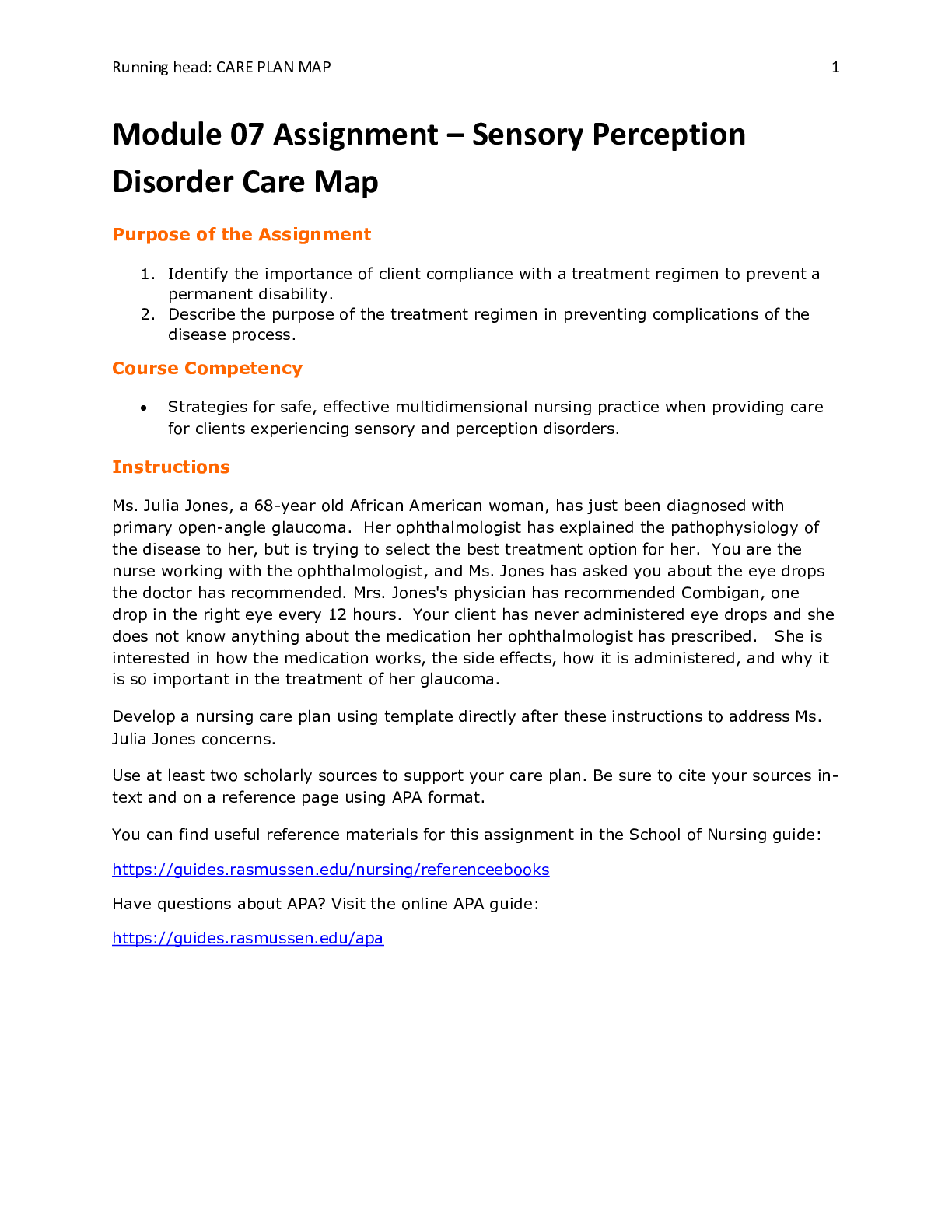
.png)


